The History Book Club discussion

This topic is about
The Liberation Trilogy Boxed Set
THE SECOND WORLD WAR
>
SECOND WORLD WAR - THE LIBERATION TRILOGY - GLOSSARY - PART TWO ~ (SPOILER THREAD)
 David I. Walsh
David I. Walsh
David Ignatius Walsh, a Senator from Massachusetts; born in Leominster, Worcester County, Mass., November 11, 1872; attended the public schools; graduated from Holy Cross College, Worcester, Mass., in 1893 and from Boston University Law School in 1897; admitted to the bar and commenced practice at Fitchburg, Mass., in 1897, later practicing in Boston; member, State house of representatives 1900-1901; lieutenant governor of Massachusetts 1913 and Governor 1914-1915; chairman of the National Governors Conference 1914-1915; delegate at large to the Massachusetts constitutional convention in 1917 and 1918; elected as a Democrat to the United States Senate and served from March 4, 1919, to March 3, 1925; unsuccessful candidate for reelection in 1924; resumed the practice of law in Boston; elected to the United States Senate on November 2, 1926, to fill the vacancy caused by the death of Henry Cabot Lodge and took his seat December 6, 1926; reelected in 1928, 1934 and 1940 for the term ending January 3, 1947; unsuccessful candidate for reelection in 1946; chairman, Committee on Education and Labor (Seventy-third and Seventy-fourth Congresses), Committee on Naval Affairs (Seventy-fourth through Seventy-seventh and Seventy-ninth Congresses); retired from political activities and resided in Clinton, Mass., until his death; died in Boston, Mass., June 11, 1947; interment in St. John’s Cemetery, Clinton, Mass.
(Source: http://bioguide.congress.gov/scripts/...)
More:
http://en.wikipedia.org/wiki/David_I....
http://www.knoxfocus.com/2012/11/davi...
http://www.govtrack.us/congress/membe...
http://outhistory.org/wiki/David_Igna...
http://cuomeka.wrlc.org/items/show/562
http://libserv23.princeton.edu/prince...
http://www.realclearpolitics.com/list...
http://www.jstor.org/discover/10.2307...
http://www.nga.org/cms/home/governors...
http://nymag.com/news/intelligencer/g...
http://www.navalhistory.org/2010/06/2...
 by
by
 Doris Kearns Goodwin
Doris Kearns Goodwin by
by
 Curt Gentry
Curt Gentry by
by
 Thomas J. Fleming
Thomas J. Fleming by David O'Toole (no photo)
by David O'Toole (no photo)(no image) Boston, the Great Depression, and the New Deal by Charles H. Trout (no photo)
Louis A. Johnson
[image error]
Louis A. Johnson, born in Roanoke, Virginia, on 10 January 1891, earned a law degree from the University of Virginia. After graduation he practiced law in Clarksburg, West Virginia; his firm, Steptoe and Johnson, eventually opened offices in Charleston, West Virginia, and Washington, D.C. Elected to the West Virginia House of Delegates in 1916, he served as majority floor leader and chairman of the Judiciary Committee. During World War I, Johnson saw action as an Army officer in France. After the war he resumed his law practice and was active in veterans' affairs, helping to found the American Legion and serving as its national commander in 1932-33. As assistant secretary of war between 1937 and 1940, Johnson advocated universal military training, rearmament, and expansion of military aviation. He practiced law from 1940 to 1949, except for several months in 1942 when he served as the president's personal representative in India.
Johnson entered office sharing the president's commitment to achieve further military unification and to control costs while maintaining adequate defense forces. These commitments insured Johnson, an outspoken and forceful leader, a stormy term in the Pentagon. At a press conference the day after he took office, Johnson promised a drastic cut in the number of NME boards, committees, and commissions, and added, "To the limit the present law allows, I promise you there will be unification as rapidly as the efficiency of the service permits it." Later, in one of his frequent speeches on unification, Johnson stated that "this nation can no longer tolerate the autonomous conduct of any single service . . . . A waste of the resources of America in spendthrift defense is an invitation to disaster for America."
It took a war to divert Johnson from his economy drive, which began on 23 April 1949, when he announced cancellation of the 65,000-ton flushdeck aircraft carrier USS United States. The Navy had been planning this ship for several years and construction had already begun. Johnson, supported by a majority of the JCS and by President Truman, stressed the need to cut costs. At least by implication, Johnson had scuttled the Navy's hope to participate in strategic air operations through use of the carrier. Abruptly resigning, Secretary of the Navy John L. Sullivan expressed concern about the future of the Marine Corps and naval aviation and about Johnson's unprecedented and arbitrary action so drastically affecting the Navy's operational plans without consulting it.
Momentous international events that demanded difficult national security decisions also marked Johnson's term. The Berlin crisis ended in May 1949, when the Russians lifted the blockade. Johnson pointed to the airlift as a technological triumph important to the future of air cargotransportation and as an example of the fruits of unification. A week after Johnson took office, the United States and 11 other nations signed the North Atlantic Treaty, creating a regional organization that became the heart of a comprehensive collective security system. After initial reservations, Johnson supported the new alliance and the program of military assistance for NATO and other U.S. allies instituted by the Mutual Defense Assistance Act of 6 October 1949.
Johnson was a controversial secretary of defense. Considered a purely political appointee by some, and trying to follow in the footsteps of a highly respected predecessor, Johnson became embroiled in controversy almost immediately. Once he had weathered the super-carrier storm, other problems bore down on himcontinued interservice quarreling, differences with Acheson, and above all the Korean War. At the time of his appointment Johnson met the president's needs; by September 1950, with the Korean conflict in full swing, he had become a liability. He returned to his law practice, which he pursued until his death in Washington at the age of 75 on 24 April 1966. In his last speech as secretary of defense the day before he left office, Johnson observed: "When the hurly burly's done and the battle is won I trust the historian will find my record of performance creditable, my services honest and faithful commensurate with the trust that was placed in me and in the best interests of peace and our national defense."
(Source: http://www.defense.gov/specials/secde...)
More:
https://en.wikipedia.org/wiki/Louis_A...
http://history.defense.gov/johnson.shtml
http://ead.lib.virginia.edu/vivaxtf/v...
http://millercenter.org/president/tru...
http://muse.jhu.edu/books/9780253111647
http://www.wvencyclopedia.org/article...
http://www.nndb.com/people/089/000057...
http://www.buddhistpeacegroup.org/pna...
 by Keith D McFarland (no photo)
by Keith D McFarland (no photo)
 by Steven L. Rearden (no photo)
by Steven L. Rearden (no photo)
 by Doris M. Condit (no photo)
by Doris M. Condit (no photo)
 by
by
 Melvyn P. Leffler
Melvyn P. Leffler
 by Arnold offner (no photo)
by Arnold offner (no photo)
[image error]
Louis A. Johnson, born in Roanoke, Virginia, on 10 January 1891, earned a law degree from the University of Virginia. After graduation he practiced law in Clarksburg, West Virginia; his firm, Steptoe and Johnson, eventually opened offices in Charleston, West Virginia, and Washington, D.C. Elected to the West Virginia House of Delegates in 1916, he served as majority floor leader and chairman of the Judiciary Committee. During World War I, Johnson saw action as an Army officer in France. After the war he resumed his law practice and was active in veterans' affairs, helping to found the American Legion and serving as its national commander in 1932-33. As assistant secretary of war between 1937 and 1940, Johnson advocated universal military training, rearmament, and expansion of military aviation. He practiced law from 1940 to 1949, except for several months in 1942 when he served as the president's personal representative in India.
Johnson entered office sharing the president's commitment to achieve further military unification and to control costs while maintaining adequate defense forces. These commitments insured Johnson, an outspoken and forceful leader, a stormy term in the Pentagon. At a press conference the day after he took office, Johnson promised a drastic cut in the number of NME boards, committees, and commissions, and added, "To the limit the present law allows, I promise you there will be unification as rapidly as the efficiency of the service permits it." Later, in one of his frequent speeches on unification, Johnson stated that "this nation can no longer tolerate the autonomous conduct of any single service . . . . A waste of the resources of America in spendthrift defense is an invitation to disaster for America."
It took a war to divert Johnson from his economy drive, which began on 23 April 1949, when he announced cancellation of the 65,000-ton flushdeck aircraft carrier USS United States. The Navy had been planning this ship for several years and construction had already begun. Johnson, supported by a majority of the JCS and by President Truman, stressed the need to cut costs. At least by implication, Johnson had scuttled the Navy's hope to participate in strategic air operations through use of the carrier. Abruptly resigning, Secretary of the Navy John L. Sullivan expressed concern about the future of the Marine Corps and naval aviation and about Johnson's unprecedented and arbitrary action so drastically affecting the Navy's operational plans without consulting it.
Momentous international events that demanded difficult national security decisions also marked Johnson's term. The Berlin crisis ended in May 1949, when the Russians lifted the blockade. Johnson pointed to the airlift as a technological triumph important to the future of air cargotransportation and as an example of the fruits of unification. A week after Johnson took office, the United States and 11 other nations signed the North Atlantic Treaty, creating a regional organization that became the heart of a comprehensive collective security system. After initial reservations, Johnson supported the new alliance and the program of military assistance for NATO and other U.S. allies instituted by the Mutual Defense Assistance Act of 6 October 1949.
Johnson was a controversial secretary of defense. Considered a purely political appointee by some, and trying to follow in the footsteps of a highly respected predecessor, Johnson became embroiled in controversy almost immediately. Once he had weathered the super-carrier storm, other problems bore down on himcontinued interservice quarreling, differences with Acheson, and above all the Korean War. At the time of his appointment Johnson met the president's needs; by September 1950, with the Korean conflict in full swing, he had become a liability. He returned to his law practice, which he pursued until his death in Washington at the age of 75 on 24 April 1966. In his last speech as secretary of defense the day before he left office, Johnson observed: "When the hurly burly's done and the battle is won I trust the historian will find my record of performance creditable, my services honest and faithful commensurate with the trust that was placed in me and in the best interests of peace and our national defense."
(Source: http://www.defense.gov/specials/secde...)
More:
https://en.wikipedia.org/wiki/Louis_A...
http://history.defense.gov/johnson.shtml
http://ead.lib.virginia.edu/vivaxtf/v...
http://millercenter.org/president/tru...
http://muse.jhu.edu/books/9780253111647
http://www.wvencyclopedia.org/article...
http://www.nndb.com/people/089/000057...
http://www.buddhistpeacegroup.org/pna...
 by Keith D McFarland (no photo)
by Keith D McFarland (no photo) by Steven L. Rearden (no photo)
by Steven L. Rearden (no photo) by Doris M. Condit (no photo)
by Doris M. Condit (no photo) by
by
 Melvyn P. Leffler
Melvyn P. Leffler by Arnold offner (no photo)
by Arnold offner (no photo)
J.P. Morgan, Jr.
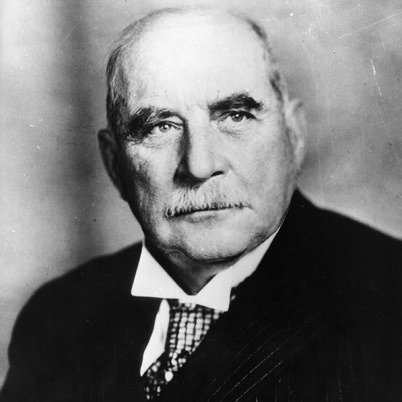
Born on September 7, 1867, in Irvington, New York, John Pierpont Morgan Jr. succeeded his father as the head of the family banking firm. J.P. Morgan Jr. worked in London, England, before assuming the mantle of leadership, and oversaw billions of dollars in transactions in support of Britain and France during World War I. In the 1920s, he donated the Morgan library to public use. He died on March 13, 1943, in Boca Grande, Florida.
Born John Pierpont Morgan Jr. was born on September 7, 1867, in Irvington, New York. The son of legendary financier John Pierpont Morgan, John Jr. followed his father's steps. Shortly after graduating from Harvard University in 1889, he went to work in his father's firm, J.P. Morgan & Company, and then moved to London to take a position at his grandfather's company, J.S. Morgan & Company.
After his father died in 1913, J.P. Morgan Jr. inherited nearly $50 million and became the head of J.P. Morgan & Company. One of his biggest deals was helping the company become the only munitions purchaser for British and French governments during World War I. The orders totaled more than $3 billion worth of supplies, and Morgan's company earned a 1 percent commission on the sale of those materials. His work for the war, however, nearly cost him his life. An intruder broke into his home in Glen Cove, Long Island, on July 3, 1915, and shot Morgan twice. The shooter, Frank Holt, wanted Morgan to stop exporting weapons. Fortunately, Morgan recovered from his injuries.
Morgan did a lot of financing deals with foreign governments after the war. He helped several countries, such as Great Britain, France, and Germany, issue bonds. He also served on a committee about German reparations in Paris in 1922 and was a delegate for the United States to a reparations conference in 1929. At home, he tried, but failed, to stop the financial panic that led to the Great Depression that same year.
In addition to his work in banking and finance, J.P. Morgan Jr. supported many organizations during his lifetime, including the Red Cross, the Episcopal Church and the New York Lying-In Hospital. He also provided an endowment to create a museum for the rare book and manuscript collection of the Morgan Library, much of which was donated by his father.
Morgan married Jane Norton Grew in 1890, and they had four children together: Junius Spencer, Jane Norton, Frances Tracy and Henry Sturgis.
Morgan died of a stroke on March 13, 1943, at a resort in Boca Grande, Florida. While he was a successful financier on his own terms, Morgan is best remembered as the son of the business giant and the continuation of a banking dynasty.
(Source:http://www.biography.com/people/jp-mo...)
More:
http://en.wikipedia.org/wiki/J._P._Mo....
http://www.nndb.com/people/934/000171...
http://theboweryboys.blogspot.com/201...
http://www.jpmorgan.com/pages/jpmorga...
http://www.mapsites.net/gotham/sec9/t...
http://www.themorgan.org/research/Fin...
 by Jean Strouse (no photo)
by Jean Strouse (no photo)
 by Charles R. Morris (no photo)
by Charles R. Morris (no photo)
 by Jeremy Byman (no photo)
by Jeremy Byman (no photo)
 by Steven H Gittelman (no photo)
by Steven H Gittelman (no photo)
 by Ovidio Diaz Espino (no photo)
by Ovidio Diaz Espino (no photo)
 by Susie J Pak (no photo)
by Susie J Pak (no photo)
 by
by
 Ron Chernow
Ron Chernow

Born on September 7, 1867, in Irvington, New York, John Pierpont Morgan Jr. succeeded his father as the head of the family banking firm. J.P. Morgan Jr. worked in London, England, before assuming the mantle of leadership, and oversaw billions of dollars in transactions in support of Britain and France during World War I. In the 1920s, he donated the Morgan library to public use. He died on March 13, 1943, in Boca Grande, Florida.
Born John Pierpont Morgan Jr. was born on September 7, 1867, in Irvington, New York. The son of legendary financier John Pierpont Morgan, John Jr. followed his father's steps. Shortly after graduating from Harvard University in 1889, he went to work in his father's firm, J.P. Morgan & Company, and then moved to London to take a position at his grandfather's company, J.S. Morgan & Company.
After his father died in 1913, J.P. Morgan Jr. inherited nearly $50 million and became the head of J.P. Morgan & Company. One of his biggest deals was helping the company become the only munitions purchaser for British and French governments during World War I. The orders totaled more than $3 billion worth of supplies, and Morgan's company earned a 1 percent commission on the sale of those materials. His work for the war, however, nearly cost him his life. An intruder broke into his home in Glen Cove, Long Island, on July 3, 1915, and shot Morgan twice. The shooter, Frank Holt, wanted Morgan to stop exporting weapons. Fortunately, Morgan recovered from his injuries.
Morgan did a lot of financing deals with foreign governments after the war. He helped several countries, such as Great Britain, France, and Germany, issue bonds. He also served on a committee about German reparations in Paris in 1922 and was a delegate for the United States to a reparations conference in 1929. At home, he tried, but failed, to stop the financial panic that led to the Great Depression that same year.
In addition to his work in banking and finance, J.P. Morgan Jr. supported many organizations during his lifetime, including the Red Cross, the Episcopal Church and the New York Lying-In Hospital. He also provided an endowment to create a museum for the rare book and manuscript collection of the Morgan Library, much of which was donated by his father.
Morgan married Jane Norton Grew in 1890, and they had four children together: Junius Spencer, Jane Norton, Frances Tracy and Henry Sturgis.
Morgan died of a stroke on March 13, 1943, at a resort in Boca Grande, Florida. While he was a successful financier on his own terms, Morgan is best remembered as the son of the business giant and the continuation of a banking dynasty.
(Source:http://www.biography.com/people/jp-mo...)
More:
http://en.wikipedia.org/wiki/J._P._Mo....
http://www.nndb.com/people/934/000171...
http://theboweryboys.blogspot.com/201...
http://www.jpmorgan.com/pages/jpmorga...
http://www.mapsites.net/gotham/sec9/t...
http://www.themorgan.org/research/Fin...
 by Jean Strouse (no photo)
by Jean Strouse (no photo) by Charles R. Morris (no photo)
by Charles R. Morris (no photo) by Jeremy Byman (no photo)
by Jeremy Byman (no photo) by Steven H Gittelman (no photo)
by Steven H Gittelman (no photo) by Ovidio Diaz Espino (no photo)
by Ovidio Diaz Espino (no photo) by Susie J Pak (no photo)
by Susie J Pak (no photo) by
by
 Ron Chernow
Ron Chernow
 William Shirer
William Shirer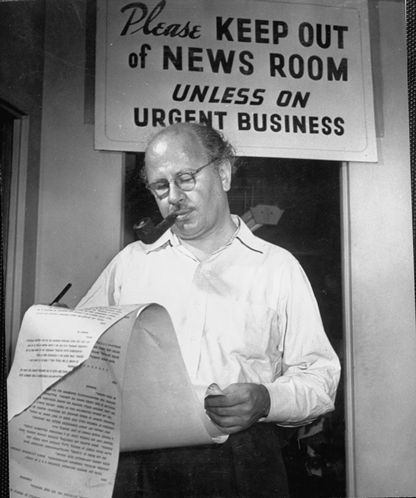
William Shirer, the son of a lawyer, was born in Chicago in 1904. When he was a child his father died and the family moved to Cedar Rapids, Iowa. He had to deliver newspapers and sell eggs to help the family finances. After leaving school he worked on the local newspaper.
In 1925 Shirer toured Europe and while in Paris found work with the Chicago Tribune. He started on the copy desk but after learning French, German, Italian and Spanish became a foreign correspondent. In 1933 Shirer married a Viennese photographer and the following year moved to Berlin to work for Universal Service.
The historian, Sally J. Taylor, has pointed out: "On the surface, he seemed a mild-mannered, ineffectual type who wore thick spectacles and puffed away blandly on his pipe, giving an appearance completely at odds with his complicated temperament and awesome intelligence. By the time he was thirty, he had worked his way up to the position of chief of the Central European bureau of the Chicago Tribune. In the following few years, he would report from practically every major capital on the Continent, as well as locations as far flung as India and Afghanistan. Quite simply, Bill Shirer knew everybody in the newspaper business in Europe."
Edward Murrow recruited Shirer to work for Columbia Broadcasting Service in 1937. As its Berlin representative, Shirer provided a regular commentary of the developments in Nazi Germany. However, the authorities kept a close watch on Shirer and most of his broadcasts were censored. It eventually became impossible for Shirer to report accurately on the situation in Germany and he left the country in December, 1940.
Shirer's book, Berlin Diary: 1933-41, was published in 1941. Other books by Shirer on Nazi Germany include End of a Berlin Diary (1947), The Rise and Fall of Nazi Germany (1959) and This Is Berlin: Reporting from Nazi Germany (1999).
William Shirer died in Berkshire Hills, Massachusetts, in 1993. (Source: http://www.spartacus.schoolnet.co.uk/...)
More:
http://en.wikipedia.org/wiki/William_...
http://www.traces.org/williamshirer.html
http://www.otr.com/shirer.shtml
http://en.wikiquote.org/wiki/William_...
http://www.youtube.com/watch?v=Qc94bC...
http://www.youtube.com/watch?v=9h7nAb...
 by
by
 William L. Shirer
William L. Shirer by Steve Wick (no photo)
by Steve Wick (no photo) by
by
 William L. Shirer
William L. Shirer by
by
 William L. Shirer
William L. Shirer by
by
 William L. Shirer
William L. Shirer by
by
 William L. Shirer
William L. Shirer
 The Atlantic Charter
The Atlantic Charter
Two months after the London Declaration came the next step to a world organization, the result of a dramatic meeting between President Roosevelt and Prime Minister Churchill.
In August 1941, the Axis was still very much in the ascendant, or so it seemed, and the carefully stage-managed meetings between Hitler and Mussolini, inevitably ending in “perfect accord,” sounded grimly foreboding. Germany had flung herself against the USSR but the might of this new ally was yet to be disclosed. And the United States, though giving moral and material succor, was not yet in the war.
"Somewhere at sea." President Roosevelt and Prime Minister Churchill on the U.S.S. Augusta, at the historic meeting which resulted in the signing of the Atlantic Charter on 14 August 1941
Then, one afternoon, came the news that President Roosevelt and Prime Minister Churchill were in conference “somewhere at sea”—the same seas on which the desperate Battle of the Atlantic was being fought— and on August 14 the two leaders issued a joint declaration destined to be known in history as the Atlantic Charter.
This document was not a treaty between the two powers. Nor was it a final and formal expression of peace aims. It was only an affirmation, as the document declared, “of certain common principles in the national policies of their respective countries on which they based their hopes for a better future for the world.”
Of the eight points of the Atlantic Charter, two bear directly on world organization. “After the final destruction of Nazi tyranny,” reads the sixth clause, “they hope to see established a peace which will afford to all nations the means of dwelling in safety within their own boundaries, and which will afford assurance that all the men in all the lands may live out their lives in freedom from fear and want.”
The seventh clause stated that such a peace should enable all men to traverse the high seas without hindrance, and the eighth concluded the document with this outline of peace organization. “They believe that all of the nations of the world, for realistic as well as spiritual reasons, must come to the abandonment of the use of force. Since no future peace can be maintained if land, sea or air armaments continue to be employed by nations which threaten, or may threaten, aggression outside of their frontiers, they believe, pending the establishment of a wider and permanent system of general security, that the disarmament of such nations is essential. They will likewise aid and encourage all other practicable measures which will lighten for peace-loving peoples the crushing burden of armaments.”
Other points of the Atlantic Charter also affirmed the basic principles of international justice: no aggrandizement; no territorial changes without the freely-expressed wishes of the peoples concerned; the right of every people to choose their own form of government; and equal access to raw materials for all nations.
A constructive purpose for the future international organization was also foreshadowed in the fifth clause, which declared that the two statesmen desired to bring about the fullest collaboration between all nations in the economic field with the object of securing, for all, improved labor standards, economic advancement and social security.
Coming from the two great democratic leaders of the day and implying the full moral support of the United States, the Atlantic Charter created a profound impression on the embattled Allies. It came as a message of hope to the occupied countries, and it held out the promise of a world organization based on the enduring verities of international morality.
That it had little legal validity did not detract from its value. If, in the ultimate analysis, the value of any treaty is the sincerity of its spirit, no affirmation of common faith between peace-loving nations could be other than important.
Support for the principles of the Atlantic Charter and a pledge of cooperation to the utmost in giving effect to them, came from a meeting of ten governments in London shortly after Mr. Churchill returned from his ocean rendezvous. This declaration was signed on September 24 by the USSR and the nine governments of occupied Europe: Belgium, Czechoslovakia, Greece, Luxembourg, the Netherlands, Norway, Poland, Yugoslavia and by the representatives of General de Gaulle, of France. (Source: http://www.un.org/en/aboutun/history/...)
More:
http://en.wikipedia.org/wiki/Atlantic...
http://avalon.law.yale.edu/wwii/atlan...
http://history.state.gov/milestones/1...
http://www.kingsacademy.com/mhodges/0...
http://www.laval.k12.nf.ca/charter1.htm
http://www.nato.int/cps/en/natolive/o...
http://histclo.com/essay/war/ww2/cou/...
http://www.historyplace.com/worldwar2...
 by David R. Facey-Crowther (no photo)
by David R. Facey-Crowther (no photo) byJesse Russell (no photo)
byJesse Russell (no photo) by
by
 Joseph E. Persico
Joseph E. Persico by
by
 Winston Churchill
Winston Churchill(no image) As He Saw It by
 Elliott Roosevelt
Elliott Roosevelt(no image) The Morgenthau Diaries by Henry Morgenthau (no photo)
 William Allen White
William Allen White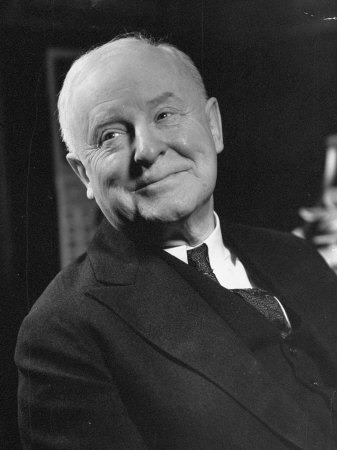
Journalist and author. Born: February 10, 1868, Emporia, Kansas. Married: Sallie Lindsay April 27, 1893. Died: January 29, 1944, Emporia, Kansas.
William Allen White was born February 10, 1868, in Emporia, Kansas, to Allen White and Mary Ann (Hatten) White. The family soon moved to El Dorado. While a teenager, White worked as a press apprentice before attending the College of Emporia and the University of Kansas. He worked as an editorial writer for the Kansas City Star. On April 27, 1893, White married Sallie Moss Lindsay. The couple moved to Emporia in 1895 and White bought the Emporia Gazette. Here he would earn the nickname “The Sage of Emporia.”
White used the editorial format of his newspaper to share his views on topics of the time. His fiery editorial, “What’s the Matter with Kansas?” published in 1896, attacked the Populist movement for its negative influence on the state and gained national attention. White would later become more sympathetic to the Populists’ viewpoints. It was at this time that White befriended future president Theodore Roosevelt.
In 1899 the Whites moved into a home at 927 Exchange Street. Their children, William Lindsay was born in 1900. Their daughter Mary Katherine was born in 1904. In 1920 the family moved out of the house as it underwent renovation. Before the family could return home, their teenage daughter, Mary, died from injuries in a horseback riding accident. In his grief, White wrote a moving eulogy that was run in newspapers nationwide, and endures yet today.
Guests to the White family home included U.S. presidents and other well-known people of the day. Author Edna Ferber learned of Oklahoma’s land rush days during such a visit and in 1929 finished the novel Cimarron, based on the topic.
Photograph of William Allen White standing next to a Dodge automobile in front of the Emporia Gazette newspaper office during his campaign against the Ku Klux Klan, 1924
White’s editorial "To an Anxious Friend," a statement for free speech, earned him the 1923 Pulitzer Prize. White ran an unsuccessful campaign for governor in 1924 based on an anti-Klan platform. The campaign did encourage Kansas to be the first state to outlaw the Klan.
In 1940 as the nation debated involvement in the war in Europe, the Committee to Defend America by Aiding the Allies was formed. William Allen White became the chair of the committee. “No other man in the country, I think, would have had the public confidence which would have enabled him to so quickly get together so large and responsible a body of the citizens,” wrote Marshall Stimpson.
White died January 29, 1944, in Emporia, after completing a chapter in his autobiography about Mary’s death. William Lindsay completed his father’s autobiography, which earned his second Pulitzer Prize. The Emporia Gazette continues to be operated by the White family. An annual children’s book award is presented in White’s name.
Sallie White continued to live in the home until her death in 1950. William Lindsay White and his family lived in the home for several years. In 1971 the house was added to the National Register of Historic Places and in 2001 it was donated to the Kansas Historical Society, and is operated as Red Rocks State Historic Site.
(Source: http://www.kshs.org/kansapedia/willia...)
More:
http://en.wikipedia.org/wiki/William_...
http://www.kansastravel.org/emporiaga...
http://www.gutenberg.org/browse/autho...
http://www.kshs.org/red_rocks
http://www.kshs.org/kansapedia/cool-t...
http://tmbw.net/wiki/William_Allen_White
http://web.archive.org/web/2008032222...
http://www2.ku.edu/~jschool/school/wa...
http://www.washburn.edu/reference/cks...
http://projects.vassar.edu/1896/white...
 by Michael S. Sherry (no photo)
by Michael S. Sherry (no photo)




 by William Allen White (no photo)
by William Allen White (no photo)
 1919 Versailles Conference
1919 Versailles Conference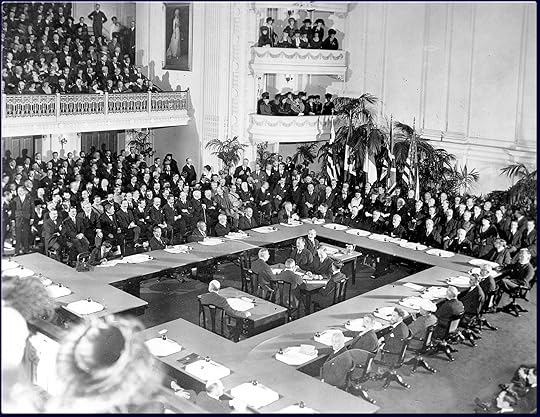

The Versailles Treaty, signed on June 28, 1919, was the peace settlement between Germany and the Allied Powers that officially ended World War I. However, the conditions in the treaty were so punitive upon Germany that many believe the Versailles Treaty laid the groundwork for the eventual rise of Nazis in Germany and the eruption of World War II.
Debated at the Paris Peace Conference
The details of the Versailles Treaty had been debated and finalized at the Paris Peace Conference, which opened on January 18, 1919 - just over two months after the fighting on the Western Front ended. Although many diplomats from the Allied Powers participated, Germany was not invited to the conference. The "big three" who were the most influential in the debates were Prime Minister David Lloyd George of the United Kingdom, Prime Minister Georges Clemenceau of France, and President Woodrow Wilson of the United States.
On May 7, 1919, the Versailles Treaty was handed over to Germany with the express instructions that they had only three weeks in which to accept the Treaty. Considering that in many ways the Versailles Treaty was meant to punish Germany, Germany of course found much fault with the Versailles Treaty. Although Germany sent back a list of complaints over the Treaty, the Allied Powers ignored most of them.
The Versailles Treaty: A Very Long Document
The Versailles Treaty itself is very long and extensive document, made up of 440 Articles (plus Annexes) which have been divided into 15 parts. The first part of the Versailles Treaty established the League of Nations. Other parts included the terms of military limitations, prisoners of war, finances, access to ports and waterways, and reparations.
Versailles Treaty Terms Spark Controversy
The most controversial aspects of the Versailles Treaty were that Germany was to take full responsibility for the damage caused during World War I (known as the "war guilt" clause, Article 231), the major land concessions forced upon Germany (including the loss of all her colonies), the limitation of the German army to 100,000 men, and the extremely large sum in reparations Germany was to pay to the Allied Powers.
The terms of the Versailles Treaty were so seemingly hostile to Germany that German Chancellor Philipp Scheidemann resigned rather than sign it. However, Germany realized they had to sign it for they no longer had any military power left to resist.
Versailles Treaty Signed
On June 28, 1919, exactly five years after the assassination of Archduke Franz Ferdinand, Germany's representatives Hermann Müller and Johannes Bell signed the Versailles Treaty in the Hall of Mirrors in the Palace of Versailles near Paris, France.
(Source: http://history1900s.about.com/od/worl...)
More:
http://en.wikipedia.org/wiki/Paris_Pe...
http://en.wikipedia.org/wiki/Treaty_o...
http://history.state.gov/milestones/1...
http://www.historylearningsite.co.uk/...
http://www.eyewitnesstohistory.com/ve...
http://www.ushmm.org/wlc/en/article.p...
http://www.youtube.com/watch?v=ShRA8H...
http://www.johndclare.net/peace_treat...
http://www.colby.edu/personal/r/rmsch...
http://www.history.com/topics/treaty-...
http://www.britannica.com/EBchecked/t...
http://library.thinkquest.org/CR02154...
http://www.ushistory.org/us/45d.asp
http://www.historytoday.com/antony-le...
http://73703070.nhd.weebly.com/the-pa...
 by Margaret MacMillan (no photo)
by Margaret MacMillan (no photo) by David Andelman (no photo)
by David Andelman (no photo) by Manfred F. Boemeke (no photo)
by Manfred F. Boemeke (no photo) by Emile Joseph Dillon (no photo)
by Emile Joseph Dillon (no photo)(no image) Versailles Twenty Years After by Birdsall P (no photo)
 Merriman Smith
Merriman Smith
(Albert) Merriman Smith (February 10, 1913 – April 13, 1970) was a Pulitzer Prize-winning wire service reporter, notably serving as White House correspondent for United Press International and its predecessor, United Press. He was born in Savannah, Georgia.
Albert Merriman Smith was born in Savannah, Georgia, on 10th February, 1913. After leaving college he became a political journalist. As White House correspondent for United Press International he covered the presidencies of Franklin D. Roosevelt, Harry S. Truman and Dwight Eisenhower.
Smith was with John F. Kennedy when he visited Dallas on 22nd November, 1963. The motorcade left Love Field at 11.45 a.m. Smith was in the National press pool car in seventh place in the procession. Also in the car was Jack Bell (Associated Press); Malcolm Kilduff (White House press secretary), Robert Baskin (Dallas Morning News ), and Bob Clark (ABC News). When the shooting took place Smith was too far back to see what happened but did hear the gunfire. As William Manchester, the author of Death of a President (1967) pointed out: “Merriman Smith decided that the longer he could keep Bell out of touch with an AP operator, the longer that lead would be. So he continued to talk. He dictated one take, two takes, three, four. Indignant, Bell rose from the center of the rear seat and demanded the phone. Smith stalled. He insisted that the Dallas operator read back the dictation. The wires overhead, he argued, might have interfered with his transmission. No one was deceived by that. Everyone in the car could hear the cackling of the UPI operator's voice. The relay was perfect. Bell, red-faced and screaming, tried to wrest the radiophone from him. Smith thrust it between his knees and crouched under the dash then surrendered the phone to Bell, and at that moment, it went dead.”
Smith reported: "Suddenly we heard three loud, almost painful loud cracks. The first sounded as if it might have been a large firecracker, but the second and third blasts were unmistakable. Gunfire. The President's car, possibly as much as 150 or 200 yards ahead, seemed to falter briefly. We saw a flurry of activity in the Secret Service follow-up car behind the chief executive's bubble-top limousine. Next in line was the car bearing Vice President Lyndon B. Johnson. Behind that, another follow-up car bearing agents assigned to the vice president's protection. We were behind that car. Our car stood still for probably only a few seconds, but it seemed like a lifetime. One sees history explode before one's eyes and for even the most trained observer, there is a limit to what one can comprehend."
On 23rd November 1963, Smith's reports were featured in a large number of newspapers. However, as William Manchester had pointed out: “Smith was not as astute a reporter as he seemed. Despite extensive experience with weapons, he had thought the sounds in the plaza were three shots from an automatic weapon, and in a subsequent message he identified them as bursts.” Smith was the first reporter to convey the news of the shooting of Kennedy. The UPI Reporter argued that the report “shows… how a top craftsman dealt with the fastest-breaking news story of his generation.”
In 1964, Smith won the Pulitzer Prize for his coverage of the assassination of US President John F. Kennedy. He was the first to use the term grassy knoll regarding the assassination. Smith was also presented with the Presidential Medal of Freedom by President Lyndon Johnson in 1967.
Merriman Smith died at his home in Washington from a self-inflicted gunshot wound on 13th April, 1970.
(Source: http://www.spartacus.schoolnet.co.uk/...)
More:
http://en.wikipedia.org/wiki/Albert_M...
http://www.arlingtoncemetery.net/albe...
http://www.findagrave.com/cgi-bin/fg....
http://newsosaur.blogspot.com/2006/12...
http://www.whca.net/smith.htm
http://www.nndb.com/people/037/000206...
http://www.tampabay.com/news/perspect...
http://www.downhold.org/lowry/kennedy...
http://www.youtube.com/watch?v=hLCP2d...
http://www.upi.com/Business_News/Secu...
 by Fletcher Knebel (no photo)
by Fletcher Knebel (no photo) by A. Merriman Smith (no photo)
by A. Merriman Smith (no photo)(no image) Merriman Smith's book of Presidents;: A White House memoir by A. Merriman Smith (no photo)
(no image) Deadline Every Minute: The Story of the United Press by Joe Alex Morris (no photo)
 J. Robert Oppenheimer
J. Robert Oppenheimer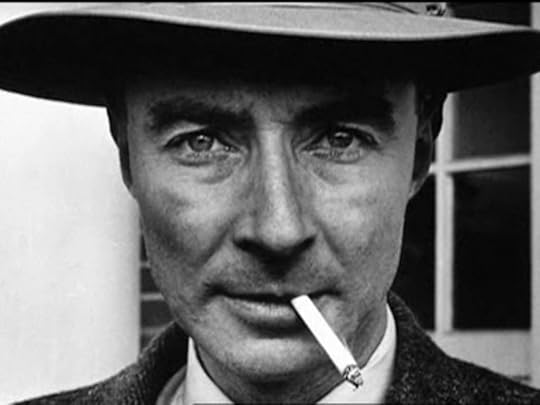
J. (Julius) Robert Oppenheimer was born in New York City on April 22, 1904. His parents, Julius S. Oppenheimer, a wealthy German textile merchant, and Ella Friedman, an artist, were of Jewish descent but did not observe the religious traditions. He studied at the Ethical Culture Society School, whose physics laboratory has since been named for him, and entered Harvard in 1922, intending to become a chemist, but soon switching to physics. He graduated summa cum laude in 1925 and went to England to conduct research at Cambridge University's Cavendish Laboratory, working under J.J. Thomson.
In 1926, Oppenheimer went to the University of Göttingen to study under Max Born, obtaining his Ph.D. at the age of 22. There, he published many important contributions to the then newly developed quantum theory, most notably a famous paper on the so-called Born-Oppenheimer approximation, which separates nuclear motion from electronic motion in the mathematical treatment of molecules. In 1927, he returned to Harvard to study mathematical physics and as a National Research Council Fellow, and in early 1928, he studied at the California Institute of Technology. He accepted an assistant professorship in physics at the University of California, Berkeley, and maintained a joint appointment with California Institute of Technology. In the ensuing 13 years, he "commuted" between the two universities, and many of his associates and students commuted with him.
Oppenheimer became credited with being a founding father of the American school of theoretical physics. He did important research in astrophysics, nuclear physics, spectroscopy and quantum field theory. He made important contributions to the theory of cosmic ray showers, and did work that eventually led toward descriptions of quantum tunneling. In the 1930s, he was the first to write papers suggesting the existence of what we today call black holes.
In November 1940, Oppenheimer married Katherine Peuning Harrison, a radical Berkeley student, and by May 1941 they had their first child, Peter. When World War II began, Oppenheimer eagerly became involved in the efforts to develop an atomic bomb, which were already taking up much of the time and facilities of Lawrence's Radiation Laboratory at Berkeley. He was invited to take over work on neutron calculations, and in June 1942 General Leslie Groves appointed Oppenheimer as the scientific director of the Manhattan Project.
Under Oppenheimer's guidance, the laboratories at Los Alamos were constructed. There, he brought the best minds in physics to work on the problem of creating an atomic bomb. In the end, he was managing more than 3,000 people, as well as tackling theoretical and mechanical problems that arose. He is often referred to as the "father" of the atomic bomb. (In 1944, the Oppenheimers' second child, Katherine (called Toni), was born at Los Alamos.) The joint work of the scientists at Los Alamos resulted in the first nuclear explosion at Alamagordo on July 16, 1945, which Oppenheimer named "Trinity."
After the war, Oppenheimer was appointed Chairman of the General Advisory Committee to the Atomic Energy Commission (AEC), serving from 1947 to 1952. It was in this role that he voiced strong opposition to the development of the hydrogen bomb. In 1953, at the height of U.S. anticommunist feeling, Oppenheimer was accused of having communist sympathies, and his security clearance was taken away. The scientific community, with few exceptions, was deeply shocked by the decision of the AEC. In 1963, President Lyndon B. Johnson attempted to redress these injustices by honoring Oppenheimer with the Atomic Energy Commission's prestigious Enrico Fermi Award.
From 1947 to 1966, Oppenheimer also served as Director of Princeton's Institute for Advanced Study. There, he stimulated discussion and research on quantum and relativistic physics in the School of Natural Sciences. Oppenheimer retired from the Institute in 1966 and died of throat cancer on February 18, 1967.
(Source: http://www.atomicarchive.com/Bios/Opp...)
More:
http://www.infoplease.com/biography/v...
http://en.wikipedia.org/wiki/J._Rober...
http://www.questia.com/library/scienc...
http://www.u-s-history.com/pages/h162...
http://www.pbs.org/wgbh/aso/databank/...
http://www.lanl.gov/history/road/oppe...
http://www.losalamoshistory.org/
http://en.wikipedia.org/wiki/Manhatta...
http://www.pitt.edu/~sdb14/atombomb.html
http://www.goodreads.com/author/quote...
http://www.biography.com/people/j-rob...
http://www.seestjohn.com/history_oppe...
 by
by
 Kai Bird
Kai Bird by
by
 Richard Rhodes
Richard Rhodes by Mark Wolverton (no photo)
by Mark Wolverton (no photo) by Ray Monk (no photo)
by Ray Monk (no photo) by Abraham Pais (no photo)
by Abraham Pais (no photo) by Jon Hunner (no photo)
by Jon Hunner (no photo) by Jennet Conant (no photo)
by Jennet Conant (no photo) by Cynthia C. Kelly (no photo)
by Cynthia C. Kelly (no photo)
 In 1957 Robert Oppenheimer and his wife purchased a piece of exclusive property on the U.S. Virgin Island of St. John at Hawksnest Bay. When Mr. Oppenheimer died in 1967 his ashes were scattered in the water along the private beach.
In 1957 Robert Oppenheimer and his wife purchased a piece of exclusive property on the U.S. Virgin Island of St. John at Hawksnest Bay. When Mr. Oppenheimer died in 1967 his ashes were scattered in the water along the private beach. A number of years ago while on St. John I took a moment to drive down his former driveway and visited the beach along with the outside of his vacant cottage. It was an awesome setting being there with in quiet solitude with no one else around. At the time his property was in limbo and destined to become part of a public park, which it is today.
 Sir Charles Wilson (Lord Moran)
Sir Charles Wilson (Lord Moran)
Charles McMoran Wilson, Lord Moran of Manton (1882-1977) had a long and active life. He was a prominent figure in the medical world, firstly as Dean of St Mary's Hospital Medical School (1920-1945), when he was responsible for rebuilding the premises and promoting the school as an undergraduate honours school. During this period he contributed to the debate on medical education, notably in his article `The Student in Irons', published in the BMJ in March 1932. He was elected president of the Royal College of Physicians (RCP), London, in April 1941, narrowly defeating the traditionalist Lord Horder, and was re-elected annually until he stepped down in favour of Russell Brain in 1950. He promoted the influence of the RCP as an independent voice for the consultants in the negotiations over the introduction of the National Health Service. He was created a baron in the New Year honours of 1943 and made his maiden speech in June of that year in the debate on the Beveridge report. He spoke powerfully in many of the debates on the NHS and was also a member of the second Spens Committee, which devised the merit awards system for consultants. He was the first chairman of the Awards Committee from 1949 to 1962 and with his vice-chairman, Sir Horace Hamilton, travelled extensively every year, working on the detail of individual recommendations for awards.
In addition to his role in medical politics he published two influential books. The Anatomy of Courage, published in February 1945, a study of the psychological effects of war, was a result of his experiences as a medical officer in the First World War and his work on shell-shock at a stationary hospital in Boulogne and later in Cambridge, where he met his wife, Dorothy Dufton. Throughout the 1930s he lectured to army colleges on morale in war and eventually brought all these thoughts together in the course of the Second World War, when he was travelling with Winston Churchill as his doctor. It is probably as Winston Churchill's doctor, that Lord Moran is best remembered and his second book Winston Churchill: Struggle for Survival, published fifteen months after his famous patient's death, was the subject of much controversy about the ethics of a doctor publishing information about a patient.
(Source: http://www.aim25.ac.uk/cgi-bin/search...)
More:
http://en.wikipedia.org/wiki/Charles_...
http://www.winstonchurchill.org/learn...
http://www.wellcome.ac.uk/News/2011/N...
http://munksroll.rcplondon.ac.uk/Biog...
http://blog.wellcomelibrary.org/label...
http://www.hektoeninternational.org/F...
http://www.hekint.org/MIH-Lord-Morans...
http://sabrinamessenger.blogspot.com/...
http://www.ncbi.nlm.nih.gov/pmc/artic...
http://www.heara.ca/content/sir-winst...
http://www.nytimes.com/learning/gener...
 by
by
 Jon Meacham
Jon Meacham by R.R.H. Lovell (no photo)
by R.R.H. Lovell (no photo)


 by
by
 Lord Moran
Lord Moran
 Maginot Line
Maginot Line
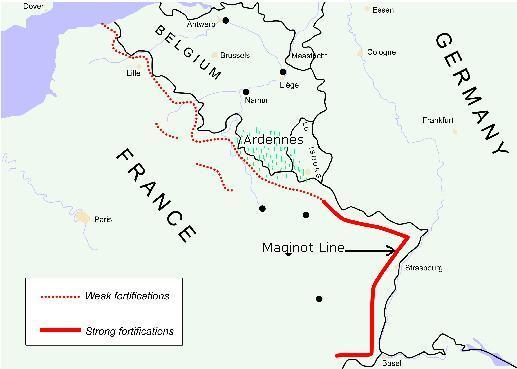
The Maginot Line dominated French military thinking in the inter-war years. The Maginot Line was a vast fortification that spread along the French/German border but became a military liability when the Germans attacked France in the spring of 1940 using blitzkrieg – a tactic that completely emasculated the Maginot Line’s purpose.
France had suffered appalling damage to both men and buildings in World War One. After Versailles in 1919, there was a clear intention on the part of the French that France should never have to suffer such a catastrophe again. After 1920, those men in both political positions and the military favoured adopting a military strategy that would simply stop any form of German invasion again.
Senior figures in the French military, such as Marshall Foch, believed that the German anger over Versailles all but guaranteed that Germany would seek revenge. The main thrust of French military policy, as a result, was to embrace the power of the defence.
As head of the armed forces, Marshall Petain commissioned a number of teams to come up with a solution to the French dilemma. Three schools of thought developed:
1)That France should adopt a policy of offence as opposed to defence. One of the main supporters of this was Charles de Gaulle. He wanted France to develop an army based on speed, mobility and mechanised vehicles. There were few who supported his ideas as many in the military saw them as aggressive and likely to provoke a response as opposed to guard against a German one.
2)France should base its military in a line of small heavily defended areas from which a counter-attack could be launched if required. Marshall Joffre favoured this idea.
3)France should build a long line of fortifications along the whole French/German border which would be both long and deep into France. Marshall Petain favoured this idea.
Maginot was Minister of War between 1922 and 1924. However, even after 1924, Maginot was involved in the project. In 1926, Maginot and his successor, Paul Painleve, got the funding for a body that was known as the Committee of Frontier Defence (CFD). The CFD was given the funding to build three sections of an experimental defence line – based on what Petain had recommended - which was to develop into the Maginot Line.
In 1929, Maginot returned to government office. He gained more money from the government to build a full-scale defence barrier along the German border. He overcame any opposition to his plan very simply – the fortification, he argued, would end any chance there was that France would suffer the terrible bloodshed of 1914 -1918 should there ever be another war. Also, in 1930, French troops that had occupied the Rhineland as part of the Versailles Treaty, had to leave the area that bordered onto France – this at a time when the Nazi Party and Hitler were making real headway in Germany.
Work on the Maginot Line proper started in 1930 when the French government gave a grant of 3 billion francs for its building. The work continued until 1940. Maginot himself died in 1932, and the line was named after him in his honour.
What exactly was the Maginot Line? It was not a continuous line of forts as some believe. In parts, especially in the south from Basle to Haguenau, it was nothing more than a series of outposts as the steep geography of the region and the River Rhine provided its own defence between France and Germany. The Line comprised of over 500 separate buildings but was dominated by large forts (known as ‘ouvrages’) which were built about nine miles from each other. Each ouvrage housed 1000 soldiers with artillery. Between each ouvrage were smaller forts which housed between 200 to 500 men depending on their size.
There were 50 ouvrages in total along the German border. Each one had the necessary fire power to cover the two nearest ouvrages to the north and south. They were protected by reinforced steel that was inches deep and capable of taking a direct hit from most known artillery fire.
The smaller forts were obviously not as well armed or protected as the ouvrages but they were still well built. They were further protected by minefields and anti-tank ditches. Forward defence lines were designed to give the defenders a good warning of an impending attack. In theory, the Maginot Line was capable of creating a massive continuous line of fire that should have devastated any attack.
However, the Maginot Line had two major failings – it was obviously not mobile and it assumed that the Ardennes was impenetrable. Any attack that could get around it would leave it floundering like a beached whale. Blitzkrieg was the means by which Germany simply went around the whole Line. By doing this, the Maginot Line was isolated and the plan that soldiers in the Line could assist the mobilised French troops was a non-starter. The speed with which Germany attacked France and Belgium in May 1940, completely isolated all the forts. The German attack was code-named “cut-of-the-sickle” (Sichlschnitt) – an appropriate name for the attack.
German Army Group B attacked through the Ardennes – such an attack was believed to be impossible by the French. One million men and 1,500 tanks crossed the seemingly impenetrable forests in the Ardennes. The Germans wanted to drive the Allies to the sea. Once the Maginot Line had been isolated it had little military importance and the Germans only turned their attention to it in early June 1940. Many of the ouvrages surrendered after the government signed its surrender with Germany – few had to be captured in battle, though some forts did fight the Germans. One in seven French divisions was a fortress division - so the Maginot Line took out 15% of the French Army. Though not a huge figure, these men may have had an impact on the advance of the Germans - or at least got evacuated at Dunkirk to fight another time.
After the war, parts of the Maginot Line were repaired and modernised to provide post-war France with more defence. Some of the forts were supposedly made nuclear war proof. However, many parts of the Maginot Line fell into disrepair and remain so.
The Maginot Line had its critics and supporters. The critics had a vast amount of evidence to support their views. However, an argument was put forward that the Maginot Line was a success and that its failure was a failure of planning in that the Line ended at the Belgium border. If the Maginot Line had been built all along the French/Belgium border, the outcome in the spring of 1940 may have been very different as the Germans would have had to go through a major fortification as opposed to going round it. It all senses, this is a superfluous argument as the Maginot Line did not go round Belgium’s border whereas the German military did go through the Ardennes therefore neutralising the Maginot Line.(Source: http://www.historylearningsite.co.uk/...)
More:
http://en.wikipedia.org/wiki/Maginot_...
http://www.history.com/topics/maginot...
http://www.spartacus.schoolnet.co.uk/...
http://europeanhistory.about.com/libr...
http://www.youtube.com/watch?v=cRQ9II...
http://www.britannica.com/EBchecked/t...
http://mysite.verizon.net/vzev1mpx/ma...
 by Rob Redman (no photo)
by Rob Redman (no photo) by William Allcorn (no photo)
by William Allcorn (no photo) by J.E. Kaufmann (no photo)
by J.E. Kaufmann (no photo) by Judith M. Hughes (no photo)
by Judith M. Hughes (no photo) by Marc Romanych (no photo)
by Marc Romanych (no photo)(no image)Fortress France by J E Kaufmann (no photo)
(no image)History of the Maginot Line by Sidney Lens (no photo)
 Bentley wrote: "What a nice story Mark. Is his home still there to be viewed?"
Bentley wrote: "What a nice story Mark. Is his home still there to be viewed?"Yes, today it has apparently been refurbished and is used as a community center.
http://www.seestjohn.com/history_oppe...
 William D. Leahy
William D. Leahy
William Daniel Leahy was born in Hampton, Iowa, on May 6, 1875. His father, Michael Leahy, a lawyer, had been Captain of Wisconsin Infantry Volunteers during the Civil War. Young Leahy originally hoped to attend West Point, but there were no appointments available. When he completed high school in Ashland, Wisc., in 1893, he was able to win an appointment to the Naval Academy. He graduated in 1897, 15th in a class of 47.
Midshipman Leahy was assigned to USS Oregon, then in the Pacific. He was in that battleship when she made her famous dash around the horn in the Spring of 1898 to participate in the battle of Santiago on July 3.
Having completed the two years' sea duty -- then required by law -- he was commissioned Ensign on 01 July 1899. At that time, he was on the Asiatic Station, where, during the Philippine Insurrection and the Boxer uprising in China, he served in USS Castine, USS Glacier and commanded the gunboat USS Mariveles. He returned to the United States in 1902, and for the next five years did duty in USS Tacoma and USS Boston which was stationed in Panama during the early period of construction of the canal.
His first shore cruise was at the Naval Academy. Beginning in 1907, he served as instructor in the Department of Physics and Chemistry for two years. He went to sea in 1909 and served as navigator of the armed cruiser USS California in the Pacific Fleet. During the American Occupation of Nicaragua in 1912, he was Chief of Staff to the Commander Naval Forces there.
Late in 1912, he came ashore in Washington as Assistant Director of Gunnery Exercises and Engineering Competitions. In 1913, he was assigned to the Bureau of Navigation as a detail officer where he served until 1915. At that time, he took command of the dispatch gunboat USS Dolphin, and established a very close friendship with the then-Assistant Secretary of the Navy Franklin D. Roosevelt, who cruised with him on the ship. He was in that assignment in early 1917 in West Indian waters and had additional duty as Senior Aide on the Staff of Commander Squadron Three of the Patrol Force Atlantic Fleet.
He served for almost a year as the Executive Officer of USS Nevada and in April 1918 went to command USS Princess Matotika, formerly Princess Alice , transporting troops to France.
After a short cruise in that command, he came ashore in 1918 and served for three years as director of Gunnery Exercises and Engineering Competition in the Navy Department, and as senior member of the Fire Control Board. In 1921, he went to sea in command of USS St. Louis, flagship of the Naval Detachment in Turkish waters during the war between Turkey and Greece. At the end of that war, he was given command of Mine Squadron One, and in 1922 further additional duty as commander, Control Force.
When he returned to the U.S. and from 1923 to 1926, he served as Director of Officer Personnel in the Bureau of Navigation, and then had one year in command of the battleship USS New Mexico. In 1927, he reached flag rank and became Chief of the Bureau of Ordnance. After almost four years, he went to sea in 1931 as Commander Destroyers Scouting Force.
In 1933, he came ashore in Washington as Chief of the Bureau of Navigation for two years, when he went to sea as a vice admiral, and Commander Battleships Battle Force. In 1936, he hoisted his four-star flag in USS California and Commander in Chief Battle Force.
He was appointed Chief of Naval Operations, took the oath of office in January 1937 to serve until August 1939 when he was placed on the retired list. On that occasion, President Roosevelt said "Bill, if we have a war, you're going to be right back here helping me run it."
Immediately following his retirement, Admiral Leahy was assigned the duties of Governor of Puerto Rico in September 1939. He served in that capacity until November 1940 when he was appointed U.S. Ambassador to France where he served from January 1941 until recalled in May 1942.
In July of that year, he was called back to active duty as Chief of Staff to the Commander in Chief, U.S. Army and Navy, the President of the United States. As such, he presided over the Joint Chiefs of Staff and, when our country was host, over the combined Chiefs. In December 1944, he accepted the appointment and was confirmed as the newly created rank of Fleet Admiral.
On 25 March 1949, the President accepted his resignation from that assignment. He continued on duty in an advisory capacity in the office of the Secreatry of the Navy, and served as President of the Naval Historical foundation.
He died on 20 July 1959.
(Source: http://www.history.navy.mil/faqs/faq3...)
More:
http://en.wikipedia.org/wiki/William_...
http://www.ibiblio.org/pha/paw/192.html
http://www.arlingtoncemetery.net/wdle...
http://www.presidency.ucsb.edu/ws/?pi...
http://memory.loc.gov/service/mss/ead...
http://www.spartacus.schoolnet.co.uk/...
 by Henry H. Adams (no photo)
by Henry H. Adams (no photo) by Walter R. Borneman (no photo)
by Walter R. Borneman (no photo) by Fleet Admirial William D. Leahy (no photo)
by Fleet Admirial William D. Leahy (no photo) by Edwin Palmer Hoyt (no photo)
by Edwin Palmer Hoyt (no photo) by William B. Hopkins (no photo)
by William B. Hopkins (no photo)
message 67:
by
Jerome, Assisting Moderator - Upcoming Books and Releases
(last edited Sep 01, 2014 11:02AM)
(new)
Henry Morgenthau

Henry Morgenthau, Jr. (1891–1967) served as United States Secretary of the Treasury in the Roosevelt and Truman administrations from January 1, 1934, until July 22, 1945. Morgenthau was born into a prominent Jewish family in New York City; his father, Henry Morgenthau Sr., was a prominent real estate investor and diplomat who served as ambassador to the Ottoman Empire.
During World War I, Morgenthau worked under Herbert Hoover (who later became US president) in the US Farm Administration of the United States Department of Agriculture. From 1922 to 1933, he was the publisher of American Agriculturist, an independent journal. In 1929, his long-time friend and then governor of New York, Franklin D. Roosevelt, appointed him State Commissioner of Conservation. Following Roosevelt's election to the presidency, Morgenthau was appointed Chairman of the Federal Farm Board (an independent and intergovernmental agency below Cabinet level) in 1933, and, in 1934, Secretary of the Treasury.
During his eleven years as Treasury Secretary, Morgenthau stabilized the US dollar, helped finance the “New Deal,” prepared the US economy for war, and financed the war effort through the sale of war bonds. Although he opposed Keynesian economics (a theory, associated with the British economist John Maynard Keynes, that government spending could end the depression) and disagreed with certain aspects of Roosevelt's “New Deal,” he was extremely loyal to Roosevelt.
Morgenthau was the only Jew in Roosevelt's cabinet. While showing some concern for the plight of Germany's Jews, he did not become actively involved in the issue until the late 1930s. In 1938, aware that the US immigration quota system was insufficient to accommodate the number of immigrants who wanted to come to the United States, he proposed to Roosevelt that the United States acquire British and French Guiana in order to use these territories as a place of refuge for immigrants from Nazi Germany. Roosevelt did not favor that particular proposal; but Morgenthau continued to bring various rescue plans to his attention.
In 1943, months after the US State Department confirmed the existence of a German policy and practice aimed at annihilating the Jews of Europe, Morgenthau became involved in the debate over rescue at the urging of some of his staff at Treasury. Disappointed with the lack of tangible results of the Bermuda Conference in the spring of 1943, and suspecting that US State Department officials had delayed issuance of a license to finance the attempt to provide for the relief and evacuation of Jews in France and Romania, Treasury officials John Pehle, Randolph Paul, and Josiah DuBois presented Morgenthau with an 18-page memorandum entitled “Report to the Secretary on the Acquiescence of This Government in the Murder of Jews" on January 13, 1944. Three days later, Morgenthau, Pehle, and Paul met with President Roosevelt. Warning of future negative assessments of the will and actions of Roosevelt administration with respect to trying to rescue European Jews, they urged the President to agree to a more focused effort by the US government to provide relief and, if possible, rescue Jews and non-Jews threatened with death in German-occupied and German-influenced Europe. The president issued an executive order establishing the War Refugee Board (WRB) on January 22, 1944.
During the same year, Morgenthau devised a plan for the occupation of Germany, known as the Morgenthau Plan. It advocated harsh measures to ensure Germany could not go to war again. According to the plan, Germany was to be partitioned into two states, its industry internationalized or annexed by neighboring countries, and its heavy industry dismantled. Although Roosevelt and British Prime Minister Winston Churchill signed a modified version of the plan in September 1944 at the Second Quebec Conference, the victorious Allies never fully implemented it. US Secretary of State Cordell Hull and US Secretary of War Henry Stimson firmly opposed the policy as did British Foreign Secretary Anthony Eden. Moreover, in the first postwar years, the Truman administration's concern about the developing “Cold War” and the need to strengthen the western zones of occupied Germany reinforced opposition to implementation of the Morgenthau Plan.
Still, the western Allies implemented some of its suggestions. For instance, the Morgenthau Plan strongly influenced Joint Chiefs of Staff Directive (JCS 1067), issued on May 10, 1945. This Directive, which remained in force until July 1947, aimed at reducing overall German living standards in order to in order to prevent Germany's reemergence as an aggressive power. It prohibited assistance to the German agricultural sector, and banned the production of oil, rubber, merchant ships, and aircraft.
Due to personal and policy differences with President Harry S. Truman, Morgenthau was forced to resign from the Treasury in July 1945. He spent much of the rest of his life working for Jewish philanthropies, including the United Jewish Appeal, and became a strong supporter of the state of Israel.
(Source:http://www.ushmm.org/wlc/en/article.p...)
More:
http://en.wikipedia.org/wiki/Henry_Mo....
http://cityroom.blogs.nytimes.com/200...
http://www.treasury.gov/about/history...
http://www.time.com/time/specials/pac...
http://www.u-s-history.com/pages/h165...
http://en.wikipedia.org/wiki/Henry_Mo....
http://www.jewishvirtuallibrary.org/j...
http://www.burtfolsom.com/wp-content/...
 by Herbert Levy (no photo)
by Herbert Levy (no photo)
 by
by
 Robert Dallek
Robert Dallek
 by Michael R. Beschloss (no photo)
by Michael R. Beschloss (no photo)
 by Henry Morgenthau (no photo)
by Henry Morgenthau (no photo)
 by Peter Balakian (no photo)
by Peter Balakian (no photo)
 by Peter Moreira (no photo)
by Peter Moreira (no photo)

Henry Morgenthau, Jr. (1891–1967) served as United States Secretary of the Treasury in the Roosevelt and Truman administrations from January 1, 1934, until July 22, 1945. Morgenthau was born into a prominent Jewish family in New York City; his father, Henry Morgenthau Sr., was a prominent real estate investor and diplomat who served as ambassador to the Ottoman Empire.
During World War I, Morgenthau worked under Herbert Hoover (who later became US president) in the US Farm Administration of the United States Department of Agriculture. From 1922 to 1933, he was the publisher of American Agriculturist, an independent journal. In 1929, his long-time friend and then governor of New York, Franklin D. Roosevelt, appointed him State Commissioner of Conservation. Following Roosevelt's election to the presidency, Morgenthau was appointed Chairman of the Federal Farm Board (an independent and intergovernmental agency below Cabinet level) in 1933, and, in 1934, Secretary of the Treasury.
During his eleven years as Treasury Secretary, Morgenthau stabilized the US dollar, helped finance the “New Deal,” prepared the US economy for war, and financed the war effort through the sale of war bonds. Although he opposed Keynesian economics (a theory, associated with the British economist John Maynard Keynes, that government spending could end the depression) and disagreed with certain aspects of Roosevelt's “New Deal,” he was extremely loyal to Roosevelt.
Morgenthau was the only Jew in Roosevelt's cabinet. While showing some concern for the plight of Germany's Jews, he did not become actively involved in the issue until the late 1930s. In 1938, aware that the US immigration quota system was insufficient to accommodate the number of immigrants who wanted to come to the United States, he proposed to Roosevelt that the United States acquire British and French Guiana in order to use these territories as a place of refuge for immigrants from Nazi Germany. Roosevelt did not favor that particular proposal; but Morgenthau continued to bring various rescue plans to his attention.
In 1943, months after the US State Department confirmed the existence of a German policy and practice aimed at annihilating the Jews of Europe, Morgenthau became involved in the debate over rescue at the urging of some of his staff at Treasury. Disappointed with the lack of tangible results of the Bermuda Conference in the spring of 1943, and suspecting that US State Department officials had delayed issuance of a license to finance the attempt to provide for the relief and evacuation of Jews in France and Romania, Treasury officials John Pehle, Randolph Paul, and Josiah DuBois presented Morgenthau with an 18-page memorandum entitled “Report to the Secretary on the Acquiescence of This Government in the Murder of Jews" on January 13, 1944. Three days later, Morgenthau, Pehle, and Paul met with President Roosevelt. Warning of future negative assessments of the will and actions of Roosevelt administration with respect to trying to rescue European Jews, they urged the President to agree to a more focused effort by the US government to provide relief and, if possible, rescue Jews and non-Jews threatened with death in German-occupied and German-influenced Europe. The president issued an executive order establishing the War Refugee Board (WRB) on January 22, 1944.
During the same year, Morgenthau devised a plan for the occupation of Germany, known as the Morgenthau Plan. It advocated harsh measures to ensure Germany could not go to war again. According to the plan, Germany was to be partitioned into two states, its industry internationalized or annexed by neighboring countries, and its heavy industry dismantled. Although Roosevelt and British Prime Minister Winston Churchill signed a modified version of the plan in September 1944 at the Second Quebec Conference, the victorious Allies never fully implemented it. US Secretary of State Cordell Hull and US Secretary of War Henry Stimson firmly opposed the policy as did British Foreign Secretary Anthony Eden. Moreover, in the first postwar years, the Truman administration's concern about the developing “Cold War” and the need to strengthen the western zones of occupied Germany reinforced opposition to implementation of the Morgenthau Plan.
Still, the western Allies implemented some of its suggestions. For instance, the Morgenthau Plan strongly influenced Joint Chiefs of Staff Directive (JCS 1067), issued on May 10, 1945. This Directive, which remained in force until July 1947, aimed at reducing overall German living standards in order to in order to prevent Germany's reemergence as an aggressive power. It prohibited assistance to the German agricultural sector, and banned the production of oil, rubber, merchant ships, and aircraft.
Due to personal and policy differences with President Harry S. Truman, Morgenthau was forced to resign from the Treasury in July 1945. He spent much of the rest of his life working for Jewish philanthropies, including the United Jewish Appeal, and became a strong supporter of the state of Israel.
(Source:http://www.ushmm.org/wlc/en/article.p...)
More:
http://en.wikipedia.org/wiki/Henry_Mo....
http://cityroom.blogs.nytimes.com/200...
http://www.treasury.gov/about/history...
http://www.time.com/time/specials/pac...
http://www.u-s-history.com/pages/h165...
http://en.wikipedia.org/wiki/Henry_Mo....
http://www.jewishvirtuallibrary.org/j...
http://www.burtfolsom.com/wp-content/...
 by Herbert Levy (no photo)
by Herbert Levy (no photo) by
by
 Robert Dallek
Robert Dallek by Michael R. Beschloss (no photo)
by Michael R. Beschloss (no photo) by Henry Morgenthau (no photo)
by Henry Morgenthau (no photo) by Peter Balakian (no photo)
by Peter Balakian (no photo) by Peter Moreira (no photo)
by Peter Moreira (no photo)
 ABC-1 Talks
ABC-1 TalksThe secret American-British Conversations (ABC-1) were the first semi-formal discussions between US and British military officers held in the months prior to the US entry into WWII. These did not constitute a formal treaty--indeed the joint declarations emanating from these talks were not in any way binding on either nation, nor were they publicized. But they did allow the two nations to spell out their national interests to each other and to explore opportunities for strategic cooperation in the event that America was drawn into the war that Britain was then bravely waging almost singlehandedly against Germany and Italy. Japan and the US were not yet active participants.
Admiral Stark, Chief of Naval Operations, took the lead in pressing for discussions with British Staff officers. General Marshal approved of the idea and the talks certainly would not have gone forward without FDR's assent, which he evidently gave on or before December 2, 1940. It was agreed to hold this "exchange of ideas" in Washington shortly after FDR's inauguration to his third term, a ceremony which took place on January 20, 1941. The ABC-1 talks were conducted from 29 January to 27 March, 1941. The two parties to these talks scrupulously avoided any participation by political representatives of either country; it was a purely military affair.
Although high ranking officers from both sides took part in these talks, none of the most senior officers on either side participated. Thus, although General Marshall and Admiral Stark, greeted the British contingent at the start of the talks, neither one took part in the actual discussions. The American participants, however, had been well briefed on what to say and not say. In fact a memorandum had been prepared expressing American objectives and strategy "should the United States be compelled to resort to war." FDR himself reviewed the memorandum and made some edits. Marshall and Stark were constantly kept informed on the progress of the talks.
One of the items in this US memorandum affirmed that although the "broad military objective of the United States operations will be the defeat of Germany and its allies," the US was also determined "to prevent the extension in the Western Hemisphere of European or Asiatic political and military power."
Those taking part in ABC-1 reached the following significant--but non-binding--conclusions.
If the U.S. went to war with Germany, it would most likely also go to war with Japan and Italy. It was agreed that America's territorial interest was the Western Hemisphere and that the security of the British Commonwealth must be maintained, including Britain's holdings in the Far East. Furthermore, it was essential to maintain sea communications between the Allied Powers.
The following offensive strategies were jointly espoused by the participants in ABC-1, but again this was all non-binding:
* The early elimination of Italy
* Support of neutrals and underground groups in resisting the Axis Powers
* Sustained aerial warfare offensive to destroy Axis military power
* Build-up of forces for the eventual offensive against Germany and the capture of positions from which to launch that offensive
* The Atlantic and European areas were the "decisive theater" and as such would be the primary focus of US military efforts, although the "great importance" of the Middle East and Africa were noted.
My source was:
"The United States Army in WWII--The War Department--Chief of Staff: Prewar Plans and Preparations" by Mark Skinner Watson, Center of Military History, United States Army
 Jill wrote: "The Atlantic Charter
Jill wrote: "The Atlantic CharterTwo months after the London Declaration came the next step to a world organization, the result of a dramatic meeting between President Roosevelt and Prime Minister Churchill..."
Thanks for bringing up the Atlantic Charter which I find is largely forgotten.
A couple of other good books on it are
Atlantic Meeting by
 H.V. Morton
H.V. Mortonwhich is news reporters journey with Churchill on the H.M.S. Prince of Wales to the rendezvous point off Placentia Bay in Newfoundland.
Also
 by Theodore A. Wilson
by Theodore A. WilsonThis is a more detailed look at the full impact of the Atlantic Charter.
 The Phony (Phoney) War
The Phony (Phoney) War 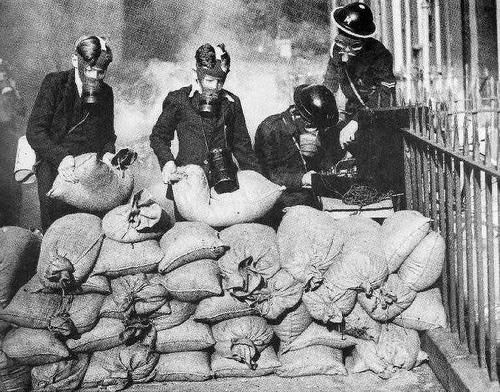
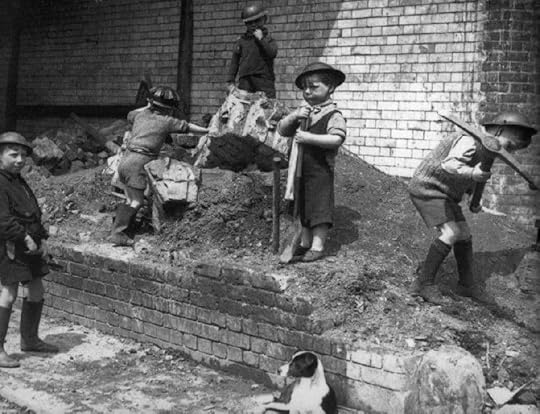
The"Phoney War" is the name given to the period of time in World War Two from September 1939 to April 1940 when, after the blitzkrieg attack on Poland in September 1939, seemingly nothing happened. Many in Great Britain expected a major calamity – but the title ‘Phoney War’ summarises what happened in Western Europe – near enough nothing.
The term 'Phoney War' was first used, allegedly, by the American Senator William Borah. Winston Churchill referred to the same period as the ‘Twilight War’ while the Germans referred to it as ‘Sitzkrieg’ – 'sitting war'.
The Phoney War refers to what happened in Western Europe between September 1939 and the spring of 1940. To assume that nothing was going on in Europe would be wrong as Poland was in the process of being occupied with all that brought for the Polish people. However, in Western Europe very little of military importance did take place. In fact, so little occurred that many of the children who had been evacuated at the start of the war, had returned to their families. To many, war had been declared by Neville Chamberlain, but nothing was actually happening.
In fact, things were happening but the public in Britain were not aware of them – or very few were. The sinking of the ‘Athenia’ sent a clear message to Britain that Germany was prepared to sink passenger liners and not just ships of military importance. The sinking of the ‘Royal Oak’ also brought the war home to Britain. Such was the shock to the government of the ‘Royal Oak’s’ sinking that many people first learned about it from the broadcasts of Lord Haw-Haw.
At 09.00 am September 3rd, U-30 attacked the ‘Athenia’ which was bound for Canada. U-30's commander, Lemp, claimed that he believed that the ‘Athenia’ was a naval boat as it was sailing in a zigzag manner and in the poor light he could not differentiate between a liner and a naval vessel. Of the 1,102 passengers and 315 crew, 112 died. Germany attempted to shift the blame for the attack on the British by claiming that British intelligence, on the orders of Winston Churchill, had placed a bomb on board ‘Athenia’. In fact, U-boat commanders had been ordered not to attack passenger liners and Hitler himself issued an order that no further attacks should be made on passenger liners unless it was obvious that they were travelling in convoy.
During the Phoney War, Britain was also engaged in ‘bombing’ raids over Germany – but it was not bombs that were dropped but propaganda leaflets. Sir Kingsley Wood, Secretary of State for War, called them “truth raids”. The ‘raids’ served two purposes:
1. The Germans would read about the evils of Nazi Germany
2. It was show the leaders of Germany just how vulnerable their country was to bombing raids.
Millions of leaflets were dropped over Germany. On September 3rd alone, 6 million copies of “Note to the German People” were dropped in just one night – the equivalent of 13 tons of paper. The main result of these initial raids was that the Germans stepped up their anti-aircraft batteries.
While some politicians believed that the raids served a purpose, others in the military did not.
“My personal view is that the only thing achieved was largely to supply the continent’s requirements of toilet paper for the five long years of the war.” wrote "Bomber Harris at the end of the war. General Spears stated, “It is ignominious to wage a confetti war against an utterly ruthless enemy.”
It is certainly true that the general public would have liked a more robust response to the attack on Poland. If our bombers were capable of dropping leaflets, it was surmised, then they should be capable of dropping bombs on important industrial targets to let the Germans know that we meant business. “The smoke and smell of German forests would teach the Germans, who were very sentimental about their own trees, that war was not always pleasant and profitable, and could not be fought entirely in other people’s countries” wrote Hugh Dalton When the issue of an attack on the Black Forest was raised with Kingsley Wood, he replied: “Oh you can not do that, that’s private property. You’ll be asking me to bomb the Ruhr next.”
In anticipation of the war breaking out, in August the Emergency Powers (Defence) Bill had received the Royal Assent. It brought into being“such defence regulations as appear necessary or expedient for securing the public safety, the defence of the realm, the maintenance of the public order and the efficient prosecution of any war in which His Majesty may be engaged, and for maintaining supplies and services essential to the life of the community.”
This law brought in:
1.The arrest, trial and punishment of anybody deemed to have gone against these regulations
2.To detain anybody deemed by the government to be a threat
3.Taking any property other than land needed by the government
4 Entering and searching any property
5.Changing any existing law if it was necessary for the war effort
Immediately the war started, the public faced a torrent of prohibitions – what they could not do – and requirements – what they had to do. Such a move did attract a considerable amount of criticism even within Parliament. Imprisonment without trial and the effective suspension of Habeas Corpus were, indeed, controversial. Dingle Foot, MP, said that Britain was fighting two wars: Nazi aggression abroad and Nazi tendencies at home.
During the Phoney War, blackout was rigidly enforced until it became obvious that problems on the roads had to be resolved. In December 1939, Westminster allowed low-density street lighting to help solve the issue of pedestrian/road accidents. Other areas soon followed. But no night time lighting of any description was allowed within 12 miles of the south-east coast. It was only on January 22nd, 1940, that the familiar car headlamps of World War Two were introduced along with a 20 mph speed limit in built-up areas. (Source: http://www.historylearningsite.co.uk/...)
More:
http://en.wikipedia.org/wiki/Phoney_War
http://www.veterans.gc.ca/eng/history...
http://oakbay.sd61.bc.ca/staff/salexa...
http://www.youtube.com/watch?v=vzudJr...
http://worldwar2database.com/html/pho...
http://www.johndclare.net/wwii3.htm
http://www.heretical.com/British/joyc...
http://histclo.com/essay/war/ww2/camp...
 by Eric Mombeek (no photo)
by Eric Mombeek (no photo) by Andrew Bird (no photo)
by Andrew Bird (no photo) by
by
 Jean-Paul Sartre
Jean-Paul Sartre by Tom Docherty (no photo)
by Tom Docherty (no photo) by Francis Selwyn (no photo)
by Francis Selwyn (no photo)(no image)The Phony War, 1939-1940 by Tom Shachtman (no photo)
 Hiroshi Oshima
Hiroshi Oshima
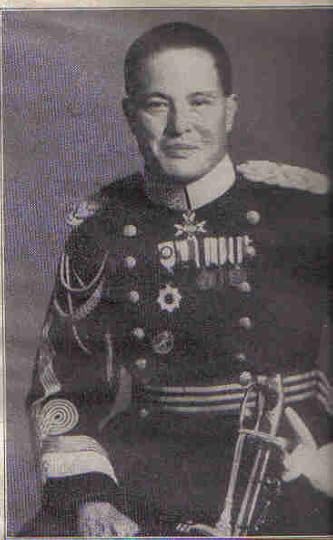
Hiroshi Oshima was born in Gifu Prefecture, Japan to one-time Minister of War Kenichi Oshima. He attended the Japanese Army Academy and completed his studies in 1906. In 1915, he completed courses at the Army War College. Between 1923 and 1924, he was a military attaché in Budapest, Hungary and Vienna, Austria. Between 1930 and 1931, he was the commanding officer of the 10th Field Artillery Regiment.
In 1934, Oshima became a military attaché in Berlin, Germany at the rank of colonel. He befriended Joachim von Ribbentrop and met Adolf Hitler in the fall of 1935. By 1938, his close working relationship with top Nazi German officials landed him the position of ambassador and the rank of lieutenant general. In this capacity, he was instrumental in the forging and signing of the Anti-Comintern Pact on 25 Nov 1936 and the Tripartite Pact on 27 Sep 1940.
Between 1939 and 1940, Oshima returned to Japan, but was sent back to Germany in early 1941 at the insistence of the German government. In late 1941, he received the Grand Cross of the Order of the German Eagle in Gold from Hitler. Becoming more and more of a confidante to Hitler, he received privileged information about German military deployments, and was given full access to tour front areas such as the Atlantic Wall and the Russian front. He regularly reported back to Tokyo, Japan regarding what he had learned. Unknowingly, he allowed the Americans to benefit from his detailed reports, as by 1940 the Americans had already broken the Japanese diplomatic code. Nearly all of his hundreds of dispatches sent between 1941 and 1945 were intercepted by the Americans, providing the Western Allies most valuable intelligence. For example, Oshima's messages in early 1944 regarding Japan's intelligence network in Spain and the implicit Spanish cooperation led to the American decision to stop supplying the neutral country of Spain petroleum products. Later that year, his detailed report of German troop deployments, defensive armaments, and mobile reserves on the French coast was intercepted by the Allies and it greatly assisted the planning and execution of the Normandy invasion. American General George Marshall later noted Oshima as "our main basis of information regarding Hitler's intentions in Europe". The fact that the Allies were monitoring his diplomatic transmissions was not made known until after Oshima's death in 1975.
On 13 Apr 1945, Oshima met with Ribbentrop for the last time. He never thought that Germany would actually lose the war despite the rapidly approaching Allied forces. He promised Ribbentrop that he would make the last stand along with the leaders of Germany. It was one of many examples of him being an ardent supporter of Nazi Germany; he was so much so that in The Rise and Fall of the Third Reich author William Shirer said Oshima was "more Nazi than the Nazis". Nevertheless, like all diplomats present in Berlin, he was ordered to evacuate later on that same day he met with Ribbentrop. The Japanese diplomatic staff evacuated to Bad Gastein, Austria, a mountain resort on 14 Apr. The staff was detained by the Americans after the German surrender and was interrogated in a resort hotel in Pennsylvania, United States.
Oshima was arrested in Japan on 16 Dec 1945 for war crimes. He was found guilty by the International Military Tribunal for conspiring to wage aggressive war on 12 Nov 1948. He served his life sentence until late 1955 when he was paroled, and in 1958 he was granted clemency. He passed away in 1975 in Tokyo, Japan.
(Source: http://ww2db.com/person_bio.php?perso...)
More:
http://en.wikipedia.org/wiki/Hiroshi_...
http://www.youtube.com/watch?v=v_w-6A...
http://www.generals.dk/general/Oshima...
http://www.cnd.org/mirror/nanjing/NMT...
http://ww2db.com/person_bio.php?perso...
http://www.zzwave.com/cmfweb/wiihist/...
http://books.stonebooks.com/record/10...
 by
by
 William L. Shirer
William L. Shirer by Stephen C. Mercado (no photo)
by Stephen C. Mercado (no photo) by Carl Boyd (no photo)
by Carl Boyd (no photo)(no image) Shadows Dancing: Japanese Espionage Against the West, 1939-1945 by Tony Matthews (no photo)
(no image) The Extraordinary Envoy: General Hiroshi Oshima and Diplomacy in the Third Reich, 1934-1939 by Carl Boyd (no photo)
(no image) The Other Nuremberg: The Untold Story of the Tokyo War Crimes TrialsArnold C. Brackman (no photo)
 Mediterranean Front
Mediterranean Front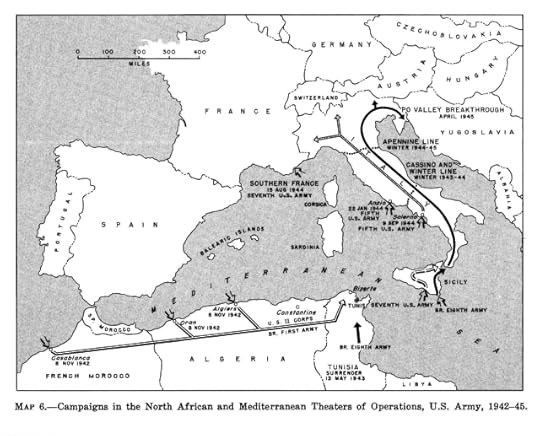

The Mediterranean Theater of Operations, United States Army (MTO USA) was originally called North African Theater of Operations (NATO). It is the American term for the theater of operations between the Allies and Axis Powers in North Africa and Italy during World War II. US operations in the theater began with of the Allied Expeditionary Force, which landed on the beaches of northwest Africa on November 8, 1942, in Operation Torch. They ended in the Italian Alps some 31 months later with the German surrender in May 1945.
(Source: http://en.wikipedia.org/wiki/Mediterr...)
More:
https://en.wikipedia.org/wiki/Mediter...
http://www.history.army.mil/html/book...
http://www.century-of-flight.net/Avia...
http://armedforcesmuseum.com/overview...
http://www.archives.gov/research/guid...

 by
by
 Douglas Porch
Douglas Porch by Vincent Jones (no photo)
by Vincent Jones (no photo) by
by
 Tim Clayton
Tim Clayton by Eric Morris (no photo)
by Eric Morris (no photo)

 by
by
 Rick Atkinson
Rick Atkinson by
by
 James Holland
James Holland

 by Barrie Pitt (no photo)
by Barrie Pitt (no photo)
 Andrew Jackson May
Andrew Jackson May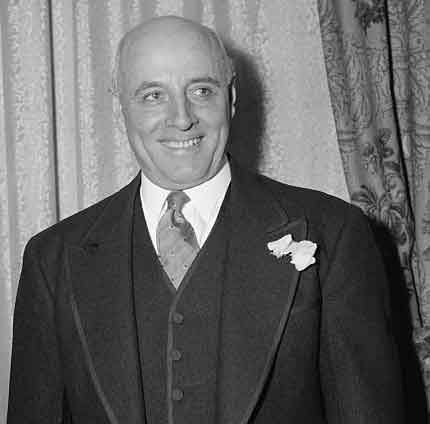
MAY, Andrew Jackson, a Representative from Kentucky; born on Beaver Creek, near Langley, Floyd County, Ky., June 24, 1875; attended the public schools; taught in the schools of Floyd and Magoffin Counties, Ky., for five years; was graduated from Southern Normal University Law School, Huntingdon, Tenn. (later Union College, Jackson, Tenn.), in 1898; was admitted to the bar the same year and commenced practice in Prestonsburg, Ky.; county attorney of Floyd County 1901-1909; special judge of the circuit court of Johnson and Martin Counties in 1925 and 1926; also engaged in agricultural pursuits, coal mining, and banking; elected as a Democrat to the Seventy-second and to the seven succeeding Congresses (March 4, 1931-January 3, 1947); chairman, Committee on Military Affairs (Seventy-sixth through Seventy-ninth Congresses); unsuccessful candidate for reelection in 1946 to the Eightieth Congress; convicted on July 3, 1947, on charges of accepting bribes for his influence in the award of munitions contracts during the Second World War; served nine months in prison during 1950 and received a full pardon from President Truman in 1952; resumed the practice of law; died in Prestonsburg, Ky., September 6, 1959; interment in Mayo Cemetery.
(Source: http://bioguide.congress.gov/scripts/...)
More:
http://en.wikipedia.org/wiki/Andrew_J...
http://history.house.gov/Collection/D...
http://www.findagrave.com/cgi-bin/fg....
 by Clay Blair Jr. (no photo)
by Clay Blair Jr. (no photo) by
by
 William Tuohy
William Tuohy(no image)Political Corruption in America: An Encyclopedia of Scandals, Power, and Greed by Mark Grossman (no photo)
Colonel Robert McCormick
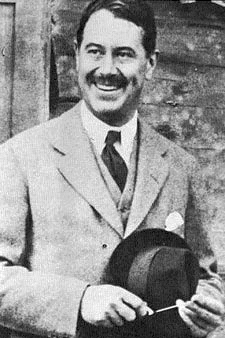

Robert Rutherford "Colonel" McCormick (1880–1955) was a member of the McCormick family of Chicago who became owner and publisher of the Chicago Tribune newspaper. A leading non-interventionist, an opponent of American entry into World War II and of the increase in Federal power brought about by the New Deal, he continued to champion a traditionalist course long after his positions had been eclipsed in the mainstream.
McCormick was born July 30, 1880 in Chicago to a distinguished family, and known as "Bertie" to his family because he had so many relatives named Robert. His maternal grandfather was Tribune founder and former Chicago mayor Joseph Medill. On his father's side, his great-uncle was inventor and businessman Cyrus McCormick. His elder brother Joseph Medill McCormick (known as Medill McCormick) was slated to take over the family newspaper business but was more interested in running for political office. From 1889 through 1893, he lived a lonely childhood with his parents in London where his father Robert Sanderson McCormick was a staff secretary to Robert Todd Lincoln and ambassador to the Austria-Hungary, Russia, and France. In London, Bertie attended Ludgrove School. On his return to the United States, he was sent to Groton School. In 1899, McCormick went to Yale College, where he was elected to the prestigious secret society Scroll and Key, graduating in 1903. He attended law school at Northwestern University School of Law and served as a clerk in a Chicago law firm, being admitted to the bar in 1907. The following year, he co-founded the law firm that became Kirkland & Ellis, which represented the Tribune Company. He was a partner until 1920. In 1910, he took control of the Chicago Tribune, becoming editor and publisher with his cousin, Captain Joseph Medill Patterson, in 1914, a position he held jointly until 1926 and by himself afterwards.
In 1904 a Republican ward leader persuaded him to run for Alderman, and he was elected, serving on the Chicago City Council for two years. In 1905, at the age of 25, he was elected to a five-year term as president of the board of trustees of the Chicago Sanitary District, operating the city's vast drainage and sewage disposal system. In 1907 he was appointed to the Chicago Charter Commission and the Chicago Plan Commission. However, his political career ended abruptly when he took control of the Tribune.
McCormick went to Europe as a war correspondent for the Tribune in February 1915, early in World War I, interviewing Tsar Nicholas, Prime Minister H. H. Asquith, and First Lord of the Admiralty Winston Churchill. He visited the Eastern and Western Fronts and was under fire on both. His father had been ambassador to Russia, and he used his contacts to attend formal dinners with Grand Duke Nicholas and Grand Duke Peter. On this trip, McCormick collected fragments of the cathedral of Ypres and the city hall of Arras. It is popularly believed that these pieces were the first of the collection of stones that were later embedded in the facade of the Tribune Tower. They are not, however, on display.
Military
Returning to the United States in 1915, he joined the Illinois National Guard on June 21, 1916, and, being an expert horseman, became a major in its 1st Cavalry Regiment. Two days earlier, President Woodrow Wilson had called the Illinois National Guard into Federal Service, along with those of several other states, to patrol the Mexican border during General John J. Pershing's Punitive Expedition. McCormick accompanied his regiment to the Mexican border.
Soon after the United States entered the war, McCormick again became part of the U.S. Army on June 13, 1917, when the entire Illinois National Guard was mobilized for Federal service in Europe. He was sent to France as an intelligence officer on the staff of General Pershing. Seeking more active service, he was assigned to an artillery school. By June 17, 1918, McCormick became a lieutenant colonel, and by September 5, 1918 had become a full colonel in the field artillery, in which capacities he saw action. He took part in the capture of Cantigny, after which he named his farm estate in Wheaton, Illinois, and in the battles of Soissons, Saint-Mihiel, and the second phase of the Argonne. He served in the 1st Battery, 5th Field Artillery Regiment, with the 1st Infantry Division. His service ended on December 31, 1918, though he remained a part of the Officers Reserve Corps from October 8, 1919 to September 30, 1929. Cited for prompt action in battle, he received the Distinguished Service Medal. Thereafter, he was always referred to as "Colonel McCormick."
McCormick returned from the war and took control of the Tribune in the 1920s. Given the lack of schools of journalism in the midwestern United States at the time, McCormick and Patterson sponsored a school named for their grandfather, the Joseph Medill School of Journalism. It was announced by Walter Dill Scott in November 1920, and began classes in 1921.
As publisher of the Tribune, McCormick was involved in a number of legal disputes regarding freedom of the press that were handled by McCormick's longtime lawyer Weymouth Kirkland. The most famous of these cases is Near v. Minnesota, 283 U.S. 697 (1931), a case championed by McCormick in his role as chairman of the American Newspaper Publishers Association's Committee on Free Speech.
A conservative Republican, McCormick was an opponent of President Franklin D. Roosevelt and compared the New Deal to Communism. For a period in 1935, he protested Rhode Island's Democratic judiciary by displaying a 47 star flag outside the Tribune building, with the 13th star (representing Rhode Island) removed; he relented after he was advised that alteration of the American flag was unlawful. He was also an America First isolationist who strongly opposed entering World War II to rescue the British Empire. As a publisher he was very innovative. McCormick was a 25 percent owner of the Tribune's 50,000 watt radio station, which was purchased in 1924; he named it WGN, the initials of the Tribune's modest motto, the "World's Greatest Newspaper".
He also established the town of Baie-Comeau, Quebec in 1936 and constructed a paper mill and a hydroelectric power plant there named McCormick Dam to generate electricity for the mill.
McCormick carried on crusades against gangsters and racketeers, prohibition and prohibitionists, local, state, and national politicians, Wall Street, the East and Easterners, Democrats, the New Deal and the Fair Deal, liberal Republicans, the League of Nations, the World Court, the United Nations, British imperialism, socialism, and communism. Besides Roosevelt, his chief targets included Chicago Mayor William Hale Thompson and Illinois Governor Len Small. Some of McCormick's personal crusades were seen as quixotic (such as his attempts to reform spelling of the English language) and were parodied in political cartoons in rival Frank Knox's Chicago Daily News. Knox's political cartoonists, including Cecil Jensen, derided McCormick as "Colonel McCosmic", a "pompous, paunchy, didactic individual with a bristling mustache and superlative ego."
In 1943 he told an audience he helped plan a defence against an invasion from Canada at the end of World War I. In June 1947 he gave a 100 year birthday party for the Tribune that included a fireworks show called "the most colossal show since the Chicago fire." Other publications noted that everything about the celebration was called "the world's greatest". Instead, they said "the Tribune has been made into a worldwide symbol of reaction, isolation, and prejudice by a man capable of real hate."
Starting in the summer of 1904, McCormick spent much time at the homes of his father's first cousin in downtown Chicago and Lake Forest, Illinois. Amanda McCormick (1822–1891), youngest daughter of family patriarch Robert McCormick, had married fellow Virginian Hugh Adams (1820–1880) before moving to Chicago to start the McCormick & Adams grain trading business. Their son Edward Shields Adams, who was born in 1859, had married the much younger Amie de Houle "Amy" Irwin, born in 1872, the daughter of decorated soldier Bernard J. D. Irwin, on April 15, 1895. However, starting in November 1913 a bitter family dispute developed.
Amy filed for divorce, claiming Adams was alcoholic, which was granted on March 6, 1914 without her husband appearing in court. Adams filed a lawsuit against McCormick for trespass and asked for the case to be heard again. By September, Adams filed another lawsuit claiming that McCormick had a former chauffeur arrested and interrogated by a private detective. The opposition press made the most out of the scandals. Adams presented McCormick with a bill for eight years of lodging, and claimed McCormick had "wickedly and maliciously debauched and carnally knew the said Amy Irwin Adams" while his guest. McCormick then claimed he had made loans to Adams, which had to be repaid. The case was heard by Federal Court Judge Kenesaw Mountain Landis in November. It was hinted that McCormick had promised to forgive the loans if the divorce was not contested. Landis ruled in favor of McCormick in February 1915.
On March 10, 1915, McCormick married Amy Irwin Adams after waiting the year after the divorce as required by law at the time. The wedding was in the registry office of St George's, Hanover Square in London with only two witnesses present. The Tribune did not mention the wedding, nor any of the previous lawsuits. After she died in 1939 he became a near social recluse. On December 21, 1944 he married Mrs. Maryland Mathison Hooper in the apartment of his cousin Chauncey McCormick. She was 47 and he was 64 at the time. She lived until July 21, 1985. He had no children from either marriage.
In failing health since an attack of pneumonia in April 1953, McCormick nevertheless remained active in his work until the month before he died on April 1, 1955. He was buried on his farm in his war uniform.
(Source: http://en.wikipedia.org/wiki/Robert_R...)
More:
https://www.cantigny.org/museums/mcco...
http://www.nytimes.com/books/97/07/13...
http://www.bookrags.com/biography/rob...
http://www.chicagohistoryjournal.com/...
http://www.firstdivisionmuseum.org/re...
http://www.firstdivisionmuseum.org/re...
http://www.dupageheritage.org/yps/mcc...
http://www.americanheritage.com/conte...
http://www.tandfonline.com/doi/abs/10...
http://www.businessweek.com/1997/31/b...
http://projects.militarytimes.com/cit...
http://blog.chicagodetours.com/2012/0...
http://www.youtube.com/watch?v=Y8qXD1...
http://www.mccormickfoundation.org/pa...
http://131.156.59.13/1997/ihy970450.html
 by Richard Norton Smith (no photo)
by Richard Norton Smith (no photo)
 by
by
 Lynne Olson
Lynne Olson
 by Chicago Tribune (no photo)
by Chicago Tribune (no photo)
An American Dynasty (no cover) by John William Tebbel (no photo)


Robert Rutherford "Colonel" McCormick (1880–1955) was a member of the McCormick family of Chicago who became owner and publisher of the Chicago Tribune newspaper. A leading non-interventionist, an opponent of American entry into World War II and of the increase in Federal power brought about by the New Deal, he continued to champion a traditionalist course long after his positions had been eclipsed in the mainstream.
McCormick was born July 30, 1880 in Chicago to a distinguished family, and known as "Bertie" to his family because he had so many relatives named Robert. His maternal grandfather was Tribune founder and former Chicago mayor Joseph Medill. On his father's side, his great-uncle was inventor and businessman Cyrus McCormick. His elder brother Joseph Medill McCormick (known as Medill McCormick) was slated to take over the family newspaper business but was more interested in running for political office. From 1889 through 1893, he lived a lonely childhood with his parents in London where his father Robert Sanderson McCormick was a staff secretary to Robert Todd Lincoln and ambassador to the Austria-Hungary, Russia, and France. In London, Bertie attended Ludgrove School. On his return to the United States, he was sent to Groton School. In 1899, McCormick went to Yale College, where he was elected to the prestigious secret society Scroll and Key, graduating in 1903. He attended law school at Northwestern University School of Law and served as a clerk in a Chicago law firm, being admitted to the bar in 1907. The following year, he co-founded the law firm that became Kirkland & Ellis, which represented the Tribune Company. He was a partner until 1920. In 1910, he took control of the Chicago Tribune, becoming editor and publisher with his cousin, Captain Joseph Medill Patterson, in 1914, a position he held jointly until 1926 and by himself afterwards.
In 1904 a Republican ward leader persuaded him to run for Alderman, and he was elected, serving on the Chicago City Council for two years. In 1905, at the age of 25, he was elected to a five-year term as president of the board of trustees of the Chicago Sanitary District, operating the city's vast drainage and sewage disposal system. In 1907 he was appointed to the Chicago Charter Commission and the Chicago Plan Commission. However, his political career ended abruptly when he took control of the Tribune.
McCormick went to Europe as a war correspondent for the Tribune in February 1915, early in World War I, interviewing Tsar Nicholas, Prime Minister H. H. Asquith, and First Lord of the Admiralty Winston Churchill. He visited the Eastern and Western Fronts and was under fire on both. His father had been ambassador to Russia, and he used his contacts to attend formal dinners with Grand Duke Nicholas and Grand Duke Peter. On this trip, McCormick collected fragments of the cathedral of Ypres and the city hall of Arras. It is popularly believed that these pieces were the first of the collection of stones that were later embedded in the facade of the Tribune Tower. They are not, however, on display.
Military
Returning to the United States in 1915, he joined the Illinois National Guard on June 21, 1916, and, being an expert horseman, became a major in its 1st Cavalry Regiment. Two days earlier, President Woodrow Wilson had called the Illinois National Guard into Federal Service, along with those of several other states, to patrol the Mexican border during General John J. Pershing's Punitive Expedition. McCormick accompanied his regiment to the Mexican border.
Soon after the United States entered the war, McCormick again became part of the U.S. Army on June 13, 1917, when the entire Illinois National Guard was mobilized for Federal service in Europe. He was sent to France as an intelligence officer on the staff of General Pershing. Seeking more active service, he was assigned to an artillery school. By June 17, 1918, McCormick became a lieutenant colonel, and by September 5, 1918 had become a full colonel in the field artillery, in which capacities he saw action. He took part in the capture of Cantigny, after which he named his farm estate in Wheaton, Illinois, and in the battles of Soissons, Saint-Mihiel, and the second phase of the Argonne. He served in the 1st Battery, 5th Field Artillery Regiment, with the 1st Infantry Division. His service ended on December 31, 1918, though he remained a part of the Officers Reserve Corps from October 8, 1919 to September 30, 1929. Cited for prompt action in battle, he received the Distinguished Service Medal. Thereafter, he was always referred to as "Colonel McCormick."
McCormick returned from the war and took control of the Tribune in the 1920s. Given the lack of schools of journalism in the midwestern United States at the time, McCormick and Patterson sponsored a school named for their grandfather, the Joseph Medill School of Journalism. It was announced by Walter Dill Scott in November 1920, and began classes in 1921.
As publisher of the Tribune, McCormick was involved in a number of legal disputes regarding freedom of the press that were handled by McCormick's longtime lawyer Weymouth Kirkland. The most famous of these cases is Near v. Minnesota, 283 U.S. 697 (1931), a case championed by McCormick in his role as chairman of the American Newspaper Publishers Association's Committee on Free Speech.
A conservative Republican, McCormick was an opponent of President Franklin D. Roosevelt and compared the New Deal to Communism. For a period in 1935, he protested Rhode Island's Democratic judiciary by displaying a 47 star flag outside the Tribune building, with the 13th star (representing Rhode Island) removed; he relented after he was advised that alteration of the American flag was unlawful. He was also an America First isolationist who strongly opposed entering World War II to rescue the British Empire. As a publisher he was very innovative. McCormick was a 25 percent owner of the Tribune's 50,000 watt radio station, which was purchased in 1924; he named it WGN, the initials of the Tribune's modest motto, the "World's Greatest Newspaper".
He also established the town of Baie-Comeau, Quebec in 1936 and constructed a paper mill and a hydroelectric power plant there named McCormick Dam to generate electricity for the mill.
McCormick carried on crusades against gangsters and racketeers, prohibition and prohibitionists, local, state, and national politicians, Wall Street, the East and Easterners, Democrats, the New Deal and the Fair Deal, liberal Republicans, the League of Nations, the World Court, the United Nations, British imperialism, socialism, and communism. Besides Roosevelt, his chief targets included Chicago Mayor William Hale Thompson and Illinois Governor Len Small. Some of McCormick's personal crusades were seen as quixotic (such as his attempts to reform spelling of the English language) and were parodied in political cartoons in rival Frank Knox's Chicago Daily News. Knox's political cartoonists, including Cecil Jensen, derided McCormick as "Colonel McCosmic", a "pompous, paunchy, didactic individual with a bristling mustache and superlative ego."
In 1943 he told an audience he helped plan a defence against an invasion from Canada at the end of World War I. In June 1947 he gave a 100 year birthday party for the Tribune that included a fireworks show called "the most colossal show since the Chicago fire." Other publications noted that everything about the celebration was called "the world's greatest". Instead, they said "the Tribune has been made into a worldwide symbol of reaction, isolation, and prejudice by a man capable of real hate."
Starting in the summer of 1904, McCormick spent much time at the homes of his father's first cousin in downtown Chicago and Lake Forest, Illinois. Amanda McCormick (1822–1891), youngest daughter of family patriarch Robert McCormick, had married fellow Virginian Hugh Adams (1820–1880) before moving to Chicago to start the McCormick & Adams grain trading business. Their son Edward Shields Adams, who was born in 1859, had married the much younger Amie de Houle "Amy" Irwin, born in 1872, the daughter of decorated soldier Bernard J. D. Irwin, on April 15, 1895. However, starting in November 1913 a bitter family dispute developed.
Amy filed for divorce, claiming Adams was alcoholic, which was granted on March 6, 1914 without her husband appearing in court. Adams filed a lawsuit against McCormick for trespass and asked for the case to be heard again. By September, Adams filed another lawsuit claiming that McCormick had a former chauffeur arrested and interrogated by a private detective. The opposition press made the most out of the scandals. Adams presented McCormick with a bill for eight years of lodging, and claimed McCormick had "wickedly and maliciously debauched and carnally knew the said Amy Irwin Adams" while his guest. McCormick then claimed he had made loans to Adams, which had to be repaid. The case was heard by Federal Court Judge Kenesaw Mountain Landis in November. It was hinted that McCormick had promised to forgive the loans if the divorce was not contested. Landis ruled in favor of McCormick in February 1915.
On March 10, 1915, McCormick married Amy Irwin Adams after waiting the year after the divorce as required by law at the time. The wedding was in the registry office of St George's, Hanover Square in London with only two witnesses present. The Tribune did not mention the wedding, nor any of the previous lawsuits. After she died in 1939 he became a near social recluse. On December 21, 1944 he married Mrs. Maryland Mathison Hooper in the apartment of his cousin Chauncey McCormick. She was 47 and he was 64 at the time. She lived until July 21, 1985. He had no children from either marriage.
In failing health since an attack of pneumonia in April 1953, McCormick nevertheless remained active in his work until the month before he died on April 1, 1955. He was buried on his farm in his war uniform.
(Source: http://en.wikipedia.org/wiki/Robert_R...)
More:
https://www.cantigny.org/museums/mcco...
http://www.nytimes.com/books/97/07/13...
http://www.bookrags.com/biography/rob...
http://www.chicagohistoryjournal.com/...
http://www.firstdivisionmuseum.org/re...
http://www.firstdivisionmuseum.org/re...
http://www.dupageheritage.org/yps/mcc...
http://www.americanheritage.com/conte...
http://www.tandfonline.com/doi/abs/10...
http://www.businessweek.com/1997/31/b...
http://projects.militarytimes.com/cit...
http://blog.chicagodetours.com/2012/0...
http://www.youtube.com/watch?v=Y8qXD1...
http://www.mccormickfoundation.org/pa...
http://131.156.59.13/1997/ihy970450.html
 by Richard Norton Smith (no photo)
by Richard Norton Smith (no photo) by
by
 Lynne Olson
Lynne Olson by Chicago Tribune (no photo)
by Chicago Tribune (no photo)An American Dynasty (no cover) by John William Tebbel (no photo)
 James W. Mott
James W. Mott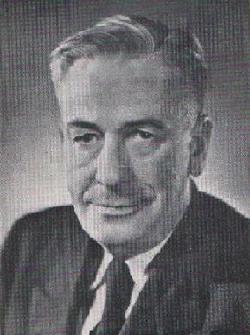
MOTT, James Wheaton, a Representative from Oregon; born near New Washington, Clearfield County, Pa., November 12, 1883; moved with his parents to Salem, Oreg., in 1890; attended the public schools, the University of Oregon at Eugene, and Stanford University, Calif.; was graduated from Columbia University, New York City, in 1909; engaged as a newspaper reporter in New York City, San Francisco, Calif., and Salem, Oreg., 1909-1917; was graduated from the law department of Willamette University, Salem, Oreg., in 1917; was admitted to the bar in the same year and commenced practice in Astoria, Oreg.; during the First World War served as a seaman first class in the United States Navy; city attorney of Astoria, Oreg., 1920-1922; member of the State house of representatives 1922-1928 and 1930-1932; moved to Salem, Oreg., in 1929; corporation commissioner of Oregon 1931-1932; elected as a Republican to the Seventy-third and to the six succeeding Congresses and served from March 4, 1933, until his death in Bethesda, Md., on November 12, 1945; interment in Mount Crest Abbey Mausoleum, Salem, Oreg.
(Source: http://bioguide.congress.gov/scripts/...)
More:
http://en.wikipedia.org/wiki/James_W....
http://www.findagrave.com/cgi-bin/fg....
http://content.wsulibs.wsu.edu/cdm/se...
 Pan American Union
Pan American Union
The notion of an international union in the New World was first put forward by Simón Bolívar who, at the 1826 Congress of Panama, proposed creating a league of American republics, with a common military, a mutual defense pact, and a supranational parliamentary assembly. This meeting was attended by representatives of Gran Colombia (comprising the modern-day nations of Colombia, Ecuador, Panama, Venezuela), Peru, and Bolivia. The United Provinces of Central America, and Mexico, but the grandly titled "Treaty of Union, League, and Perpetual Confederation" was ultimately ratified only by Gran Colombia. Bolívar's dream soon floundered with civil war in Gran Colombia, the disintegration of Central America, and the emergence of national rather than continental outlooks in the newly independent American republics. Bolívar's dream of American unity was meant to unify Latin American nations against imperial domination by external power.
The pursuit of regional solidarity and cooperation again came to the forefront in 1889–1890, at the First International Conference of American States. Gathered together in Washington, D.C., 18 nations resolved to found the International Union of American Republics, served by a permanent secretariat called the Commercial Bureau of the American Republics (renamed the "International Commercial Bureau" at the Second International Conference in 1901–1902). These two bodies, in existence as of 14 April 1890, represent the point of inception to which today's OAS and its General Secretariat trace their origins.
At the Fourth International Conference of American States (Buenos Aires, 1910), the name of the organization was changed to the "Union of American Republics" and the Bureau became the "Pan American Union". The Pan American Union Building was constructed in 1910, on Constitution Avenue, Northwest, Washington, D.C.
In the mid-1930s, U.S. President Franklin Delano Roosevelt organized an inter-American conference in Buenos Aires. One of the items at the conference was a "League of Nations of the Americas", an idea proposed by Colombia, Guatemala, and the Dominican Republic. At the subsequent Inter-American Conference for the Maintenance of Peace, 21 nations pledged to remain neutral in the event of a conflict between any two members. The experience of World War II convinced hemispheric governments that unilateral action could not ensure the territorial integrity of the American nations in the event of extra-continental aggression. To meet the challenges of global conflict in the postwar world and to contain conflicts within the hemisphere, they adopted a system of collective security, the Inter-American Treaty of Reciprocal Assistance (Rio Treaty) signed in 1947 in Rio de Janeiro.
The Ninth International Conference of American States was held in Bogotá between March and May 1948 and led by United States Secretary of State George Marshall, a meeting which led to a pledge by members to fight communism in the western hemisphere. This was the event that saw the birth of the OAS as it stands today, with the signature by 21 American countries of the Charter of the Organization of American States on 30 April 1948 (in effect since December 1951). The meeting also adopted the American Declaration of the Rights and Duties of Man, the world's first general human rights instrument, Bogotá considered the first defensive state in the event of war, of the Organization of American States.
The transition from the Pan American Union to OAS was smooth. The Director General of the former, Alberto Lleras Camargo, became the Organization's first Secretary General. The current Secretary General is former Chilean minister of the interior and foreign minister José Miguel Insulza. (source: http://en.wikipedia.org/wiki/Organiza...)
More:
http://www.infoplease.com/encyclopedi...
http://en.wikipedia.org/wiki/Pan-Amer...
http://www.answers.com/topic/pan-amer...
http://www.partt.org/castro_significa...
http://www.presidency.ucsb.edu/ws/?pi...
http://www.oas.org/juridico/english/t...
http://www.oas.org/en/about/who_we_ar...
 by John Edwin Fagg (no photo)
by John Edwin Fagg (no photo) by Carolyn M. Shaw (no photo)
by Carolyn M. Shaw (no photo) by David Sheinin (no photo)
by David Sheinin (no photo) by Barbara Lee Bloom (no photo)
by Barbara Lee Bloom (no photo)(no image)America house; a scheme for creating in Paris an association similar to the Washington Pan American Union by R. L Lomba (no photo)
 Phil Rizzuto
Phil Rizzuto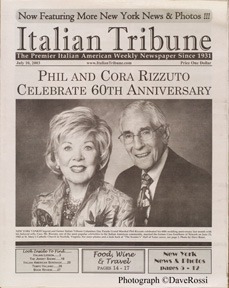
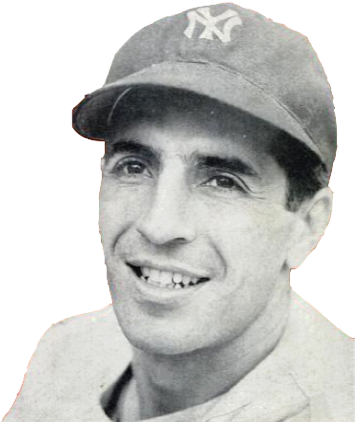
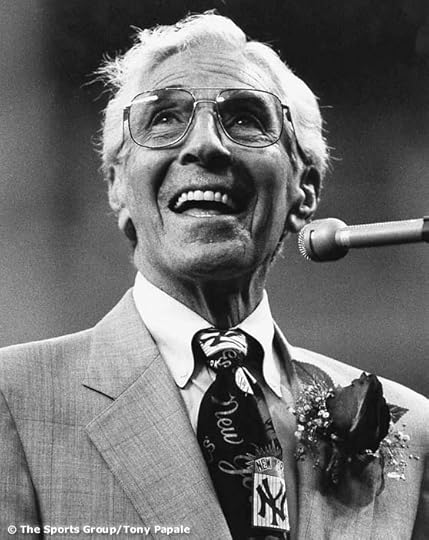
Phil Rizzuto (Baseball. Born, New York, NY, Sept. 25, 1917; died, West Orange, NJ, Aug. 13, 2007.) Philip Francis Rizzuto was a part of the New York Yankees longer than any other man in the history of the franchise, except perhaps only public address announcer Bob Sheppard. Joining the team in 1941 as a reserve shortstop, Rizzuto remained almost continuously with the organization for over a half-century, as a player and then as a broadcaster. Rizzuto was an integral member of nine pennant-winning Yankee teams. During the 1940s, when the Yankees and the Boston Red Sox perennially battled for the pennant and the Yankees almost always won, Red Sox great Ted Williams maintained that the difference between the two teams was Rizzuto. He made the plays that the Red Sox infielders did not, thereby snuffing out opposition rallies day after day. Rizzuto was also the master of the bunt. He could put one down at any time on any count against any pitcher or any infield and generally beat it out. Except for three seasons in military service (1943-45), Rizzuto was the regular shortstop for the Yankees from 1941-55. He was released by the Yanks Aug. 26, 1956, but was to return shortly as a radio and television announcer. He called Yankees games, primarily on WPIX-11, from 1957-95. During his career as a player, Rizzuto played 1,661 games and batted .273 for 13 seasons. His best season was 1950, when he batted .324 and he was the American League’s M.V.P. That year, he also hit a career-high seven homers.
(Source: http://sports.nyhistory.org/phil-rizz...)
More:
http://en.wikipedia.org/wiki/Phil_Riz...
http://www.baseballinwartime.com/play...
http://mlb.mlb.com/news/article.jsp?y...
http://sportsillustrated.cnn.com/base...
http://usatoday30.usatoday.com/sports...
http://www.washingtonpost.com/wp-dyn/...
 by Carlo DeVito (no photo)
by Carlo DeVito (no photo)
 by Phil Rizzuto (no photo)
by Phil Rizzuto (no photo) by
by
 Marty Appel
Marty Appel(no image) Phil Rizzuto: A Yankee Tradition by Dan Hirshberg (no photo)
 Woodrow Wilson
Woodrow Wilson
Woodrow Wilson was one of America's greatest Presidents. His domestic program expanded the role of the federal government in managing the economy and protecting the interests of citizens. His foreign policy established a new vision of America's role in the world. And he helped to make the White House the center of power in Washington. Most historians rank him among the five most important American Presidents, along with Washington, Lincoln, and the two Roosevelts.
Born in Virginia in 1856 and raised in Georgia and South Carolina, Wilson's early memories included seeing Yankee soldiers marching into Augusta at the end of the Civil War. Wilson's father was a Presbyterian minister who fervently supported the South's secession from the Union. Because of the war's disruption, much of Wilson's early education came from his father at home. In 1875, he entered Princeton, graduating in 1879. After a brief period at the law school of the University of Virginia, he studied on his own and passed the Georgia bar examination. Bored as a lawyer in Atlanta, he enrolled at Johns Hopkins University, where he earned a Ph.D. in history and political science in 1886.
After a successful academic career as an author and professor at Bryn Mawr, Wesleyan, and Princeton, Wilson was elected president of Princeton in 1902. In that office, his efforts to modernize the college brought him attention as a progressive reformer, and in 1910, New Jersey Democrats approached him about running for governor. Wilson accepted, but on the condition that their support came with "no strings attached."
Rapid Rise to National Power
From this point, Wilson's rise to national power was astonishingly rapid. As governor of New Jersey, he immediately began to fight machine politics and party bosses, securing campaign finance reform, a primary law permitting voters rather than party bosses to nominate candidates, and a program to compensate workers injured on the job. In 1912, Wilson used his reputation as a progressive with strong Southern roots to run for the presidency as a Democrat. After narrowly winning the Democratic nomination, he faced a divided Republican Party. William Taft, the incumbent President, carried the official Republican nomination, but Theodore Roosevelt, believing that Taft had betrayed the cause of reform, walked out of the Republican convention and formed the short-lived Progressive or "Bull Moose" Party. Taft and Roosevelt split the Republican vote, and Wilson won the election with a little less than 42 percent of the vote.
Wilson's New Freedom platform was ambitious and thoroughly progressive. It called for tariff reduction, reform of the banking and monetary system, and new laws to weaken abusive corporations and restore economic competition. With a Presbyterian's confidence that God was guiding his course, Wilson pursued his New Freedom agenda with the zeal of a crusader, making use of his skill as an orator to galvanize the nation in support of his policies. Perhaps his greatest achievement was the passage of the Federal Reserve Act of 1913, which created the system that still provides the framework for regulating the nation's banks, credit, and money supply today. Other Wilson-backed legislation put new controls on big business and supported unions to ensure fair treatment of working Americans.
In 1914, World War I began in Europe, and with the United States trying to remain neutral, foreign policy played an important role in the 1916 presidential election. In addition to a bold program of reforms that attracted the support of farmers and laborers, Wilson's campaign slogan, "He Kept Us Out of War," helped him win reelection by a narrow margin.
Aggressive Policies
In foreign affairs, Wilson was determined to revise the imperialist practices of earlier administrations, promising independence to the Philippines and making Puerto Ricans American citizens. But Wilson's own policies could sometimes be high-handed. His administration intervened militarily more often in Latin America than any of his predecessors. In the European war, American neutrality ended when the Germans refused to suspend submarine warfare after 120 Americans were killed aboard the British liner Lusitania and a secret German offer of a military alliance with Mexico against the United States was uncovered. In 1917, Congress voted overwhelmingly to declare war on Germany.
With the nation at war, Wilson set aside his domestic agenda to concentrate on a full-scale mobilization of the economy and industry. During the war, industrial production increased by 20 percent, daylight saving time was instituted to save fuel, the government took over the railroad system, and massive airplane and shipbuilding programs were launched. Americans began paying a new income tax and buying Liberty Bonds to pay for the war. Although most of the power the federal government acquired over the economy during the war was based on voluntary cooperation by businesses and individuals, conformity and aggressive patriotism became the order of the day. Private patriotic organizations persecuted dissenters and anyone suspected of political radicalism, and the administration sponsored Espionage and Sedition Acts that outlawed criticism of the government, the armed forces, and the war effort. Violators of the law were imprisoned or fined, and even mainstream publications were censored or banned.
League of Nations
In January 1918, Wilson made a major speech to Congress in which he laid out "Fourteen Points" that he believed would, if made the basis of a postwar peace, prevent future wars. Trade restrictions and secret alliances would be abolished, armaments would be curtailed, colonies and the national states that made up the Austro-Hungarian and Ottoman empires would be set on the road to independence, the German-occupied portions of France and Belgium would be evacuated, the revolutionary government of Russia would be welcomed into the community of nations, and a League of Nations would be created to maintain the peace. Believing that this revolutionary program required his personal support, Wilson decided that he would lead the American peace delegation to Paris, becoming the first President ever to go to Europe while in office. Despite Wilson's best efforts, however, the Treaty of Versailles, signed in June 1919, departed significantly from the Fourteen Points, leaving both the Germans and many Americans bitterly disillusioned.
Following his return to the United States in July 1919, Wilson presented the treaty to the Senate and spent much of the summer trying to build bipartisan support among senators for its approval, arguing that although imperfect, it was better than the sort of punitive treaty the British and French would have imposed on Germany. In September, having little success in winning Senate votes, Wilson began an arduous speaking tour to build public interest in the treaty and to promote U.S. participation in the new League of Nations. Near the end of the tour, he collapsed from exhaustion, and a few days later, after returning to the White House, he suffered a massive stroke. For the last seventeen months of his term, he was an invalid, seeing almost no one except his doctors and his second wife, Edith Bolling Wilson, through whom he conducted public business. Refusing to compromise with the Senate on amendments to the treaty, Wilson eventually told his supporters to vote against it. The Senate voted twice on the treaty—in November 1919 and March 1920—defeating it both times. Thus, the United States never joined the international organization that Wilson saw as the keystone of his new world order.
Though he left office broken and defeated, Wilson believed firmly that his vision of America leading a world community of nations would eventually be embraced by the American people. Twenty-five years later, the United Nations built its headquarters in New York, a tangible symbol of the bipartisan support that Wilsonian ideals had gained after a second world war. But Wilson's legacy was not confined to foreign policy. His progressive domestic programs helped stabilize and humanize a huge industrial system, and his success in making the presidency the intellectual and political leader of the American government enabled the United States to deal effectively with the challenges and threats of the modern world.
(Source: http://millercenter.org/president/wil...)
More:
http://en.wikipedia.org/wiki/Woodrow_...
http://www.whitehouse.gov/about/presi...
http://www.woodrowwilson.org/
http://www.nobelprize.org/nobel_prize...
http://www.pbs.org/wgbh/amex/wilson/
http://www.woodrowwilsonhouse.org/
 by John Milton Cooper Jr. (no photo)
by John Milton Cooper Jr. (no photo) by Thomas J. Knock (no photo)
by Thomas J. Knock (no photo) by
by
 H.W. Brands
H.W. Brands by Kendrick A. Clements (no photo)
by Kendrick A. Clements (no photo)


 by Arthur S. Link (no photo)
by Arthur S. Link (no photo)(no image)Wilson, Volume II: The New Freedom by Arthur S. Link (no photo)
(no image) Wilson, Volume III: The Struggle for Neutrality, 1914-1915 by Arthur S. Link (no photo)
(no image) Wilson, Vol. 5: Campaigns for Progressivism and Peace, 1916-1917 Arthur S. Link (no photo)
 Plan Dog
Plan Dog
The Plan Dog memorandum was a 1940 American government document written by Chief of Naval Operations Harold Rainsford Stark, "one of the best known documents of World War II". Confronting the problem of an expected two front war against Germany and Italy in Europe and Japan in the Pacific, the memo set out the main options and suggested fighting a defensive war in the Pacific while giving strategic priority to defeating Germany and Italy. The memo laid the basis for the later American policy of Europe first.
During the Interwar period, the Joint Planning Committee (which later became the Joint Chiefs of Staff) devised a series of contingency plans for dealing with the outbreak of war with various countries. The most elaborate of these, War Plan Orange, dealt with the possibility of war with Japan.
In light of the events of the late 1930s (the outbreak of the Second Sino-Japanese War, the Molotov-Ribbentrop Pact, the German conquest of Poland and Western Europe) American planners realized that the United States faced the possibility of a two-front war in both Europe and the Pacific. War Plan Orange was withdrawn, and five "Rainbow" plans were put forward. Unlike the earlier colored plans which had assumed a one-on-one war, the Rainbow plans contemplated possibility of fighting multiple enemies, and the necessity of defending other western hemisphere nations and aiding Britain.
The memorandum built upon the conditions described in the Rainbow Five war plan. It described four possible scenarios for American participation in World War II, lettered A through D:
A - Defend the western hemisphere
B - Go on the offensive in the Pacific against Japan while remaining on the defensive in the Atlantic
C - Fight equally committed in both the Atlantic and Pacific
D - Go on the offensive in the Atlantic (against Germany and Italy) while remaining on the defensive in the Pacific.
The memorandum, which was submitted to Roosevelt on November 12, 1940, recommended option D, from which it gets its name ("Dog" was D in the Joint Army/Navy Phonetic Alphabet).
"I believe that the continued existence of the British Empire, combined with building up a strong protection in our home areas, will do most to ensure the status quo in the Western Hemisphere, and to promote our principal national interests. As I have previously stated, I also believe that Great Britain requires from us very great help in the Atlantic, and possibly even on the continents of Europe or Africa, if she is to be enabled to survive. In my opinion Alternatives (A), (B), and (C) will most probably not provide the necessary degree of assistance, and, therefore, if we undertake war, that Alternative (D) is likely to be the most fruitful for the United States, particularly if we enter the war at an early date. Initially, the offensive measures adopted would, necessarily, be purely naval. Even should we intervene, final victory in Europe is not certain. I believe that the chances for success are in our favor, particularly if we insist upon full equality in the political and military direction of the war."
The memo also suggested that until hostilities broke out, the US should adopt policy A: "Until such time as the United States should decide to engage its full forces in war, I recommend that we pursue a course that will most rapidly increase the military strength of both the Army and the Navy, that is to say, adopt Alternative (A) without hostilities".
The strategy of Plan Dog gained the support of the army and implicitly of President Roosevelt, though he never formally endorsed it. Thus at the end of 1940 a powerful consensus for strategic focus on Germany developed at the highest levels of the American government. At a meeting on January 17, 1941, Roosevelt concluded that the primary objective must be maintenance of the supply lines to Britain and ordered the navy to prepare for the escort of convoys." A few weeks after the Attack on Pearl Harbor, at the Arcadia Conference, the United States adopted the recommendations of the memo in the form of the "Europe first" policy. Although the United States did not go entirely on the defensive in the Pacific as the memo recommended, throughout the war the European theater was given higher priority in resource allocation. (Source: http://en.wikipedia.org/wiki/Plan_Dog...)
More:
http://docs.fdrlibrary.marist.edu/psf....
http://www.history.navy.mil/photos/pe...
http://ariwatch.com/Links/RainbowFive...
http://www.history.army.mil/books/wwi...
http://www.ibiblio.org/hyperwar/USA/U...
http://pabook.libraries.psu.edu/palit...
http://numistamp.com/World-War-2-%E2%...
 Ronald H. Spector (no photo)
Ronald H. Spector (no photo) by Waldo Heinrichs (no photo)
by Waldo Heinrichs (no photo) by Inter-Allied Inter-Allied Conference (no photo)
by Inter-Allied Inter-Allied Conference (no photo) by Mark A. Stoler (no photo)
by Mark A. Stoler (no photo) by Steven L. Rearden (no photo)
by Steven L. Rearden (no photo)(no image)Admiral Harold R. Stark: Architect of Victory, 1939-1945 by B. Mitchell Simpson (no photo)
 Senate Munitions Committee
Senate Munitions Committee
On a hot Tuesday morning following Labor Day in 1934, several hundred people crowded into the Caucus Room of the Senate Office Building to witness the opening of an investigation that journalists were already calling “historic.” Although World War I had been over for 16 years, the inquiry promised to reopen an intense debate about whether the nation should ever have gotten involved in that costly conflict.
The so-called “Senate Munitions Committee” came into being because of widespread reports that manufacturers of armaments had unduly influenced the American decision to enter the war in 1917. These weapons’ suppliers had reaped enormous profits at the cost of more than 53,000 American battle deaths. As local conflicts reignited in Europe through the early 1930s, suggesting the possibility of a second world war, concern spread that these “merchants of death” would again drag the United States into a struggle that was none of its business. The time had come for a full congressional inquiry.
To lead the seven-member special committee, the Senate’s Democratic majority chose a Republican—42-year-old North Dakota Senator Gerald P. Nye. Typical of western agrarian progressives, Nye energetically opposed U.S. involvement in foreign wars. He promised, “when the Senate investigation is over, we shall see that war and preparation for war is not a matter of national honor and national defense, but a matter of profit for the few.”
Over the next 18 months, the “Nye Committee” held 93 hearings, questioning more than 200 witnesses, including J. P. Morgan, Jr., and Pierre du Pont. Committee members found little hard evidence of an active conspiracy among arms makers, yet the panel’s reports did little to weaken the popular prejudice against “greedy munitions interests.”
The investigation came to an abrupt end early in 1936. The Senate cut off committee funding after Chairman Nye blundered into an attack on the late Democratic President Woodrow Wilson. Nye suggested that Wilson had withheld essential information from Congress as it considered a declaration of war. Democratic leaders, including Appropriations Committee Chairman Carter Glass of Virginia, unleashed a furious response against Nye for “dirtdaubing the sepulcher of Woodrow Wilson.” Standing before cheering colleagues in a packed Senate Chamber, Glass slammed his fist onto his desk until blood dripped from his knuckles.
Although the Nye Committee failed to achieve its goal of nationalizing the arms industry, it inspired three congressional neutrality acts in the mid-1930s that signaled profound American opposition to overseas involvement.
(Source: http://www.senate.gov/artandhistory/h...)
More:
http://en.wikipedia.org/wiki/Nye_Comm...
http://en.wikipedia.org/wiki/Merchant...
http://www.spartacus.schoolnet.co.uk/...
http://www.conservapedia.com/Nye_Comm...
https://www.mtholyoke.edu/acad/intrel...
http://archive.org/details/munitionsi...
http://digital.hagley.org/cdm/ref/col...
http://www.ndstudies.org/articles/nor...
http://www.politico.com/news/stories/...
http://www.blackwellreference.com/pub...
http://boatagainstthecurrent.blogspot...
(no image) Congress Investigates: A Documented History, 1792-1974 by
 Arthur M. Schlesinger Jr.
Arthur M. Schlesinger Jr. by Stuart D. Brandes (no photo)
by Stuart D. Brandes (no photo) by Matthew Ware Coulter (no photo)
by Matthew Ware Coulter (no photo) by
by
 W. Cleon Skousen (no photo)
W. Cleon Skousen (no photo)(no image) War Powers: The Politics of Constitutional Authority by Mariah Zeisberg (no photo)
 Senator Gerald Nye
Senator Gerald Nye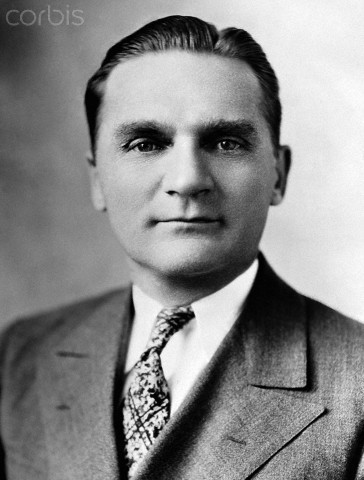
Gerald Prentice Nye, a Senator from North Dakota; born in Hortonville, Outagamie County, Wis., December 19, 1892; attended the public schools; engaged in newspaper work in Wisconsin and Iowa; moved to North Dakota in 1915; publisher of the Billings County Pioneer, and later editor and publisher of the Griggs County Sentinel-Courier; unsuccessful candidate in 1924 for election to the Sixty-ninth Congress; appointed on November 14, 1925, and subsequently elected on June 30, 1926, as a Republican to the United States Senate to fill the vacancy caused by the death of Edwin F. Ladd; reelected in 1926, 1932, and again in 1938 and served from November 14, 1925, to January 3, 1945; unsuccessful candidate for reelection in 1944; chairman, Committee on Public Lands and Surveys (Seventieth through Seventy-second Congresses), Special Committee on Investigation of the Munitions Industry (1934-1938); president of Records Engineering, Inc., Washington, D.C., 1937-1959; special assistant for elderly housing, Federal Housing Administration 1960-1964; member of staff, Senate Committee on Aging 1964-1968; associate in firm of Hurley, Clark and Associates, 1964-1971; was a resident of Chevy Chase, Md., until his death on July 17, 1971, in Washington, D.C.; interment in Fort Lincoln Cemetery.
(Source: http://bioguide.congress.gov/scripts/...)
More:
http://en.wikipedia.org/wiki/Gerald_Nye
http://www.spartacus.schoolnet.co.uk/...
http://www.answers.com/topic/gerald-nye
http://en.wikipedia.org/wiki/Nye_Comm...
http://histclo.com/essay/war/ww2/cou/...
http://www.senate.gov/artandhistory/h...
http://www.digitalhistory.uh.edu/hist...
http://news.google.com/newspapers?id=...
http://old.post-gazette.com/lifestyle...
http://www.ecommcode2.com/hoover/rese...
http://afrbr.blogspot.com/2011/02/sen...
 by Matthew Ware Coulter (no photo)
by Matthew Ware Coulter (no photo) by John Arthur Garraty (no photo)
by John Arthur Garraty (no photo)(no image) Congress Investigates: A Documented History, 1792-1974 by
 Arthur M. Schlesinger Jr.
Arthur M. Schlesinger Jr.(no image) War Powers: The Politics of Constitutional Authority by Mariah Zeisberg (no photo)
(no image) Senator Gerald P. Nye and American Foreign Relations by Wayne S. Cole (no photo)
(no image) Three Faces Of Midwestern Isolationism: Gerald P. Nye, Robert E. Wood, John L. Lewis by John N. Schacht (no photo)
 Merchants of Death, the book
Merchants of Death, the book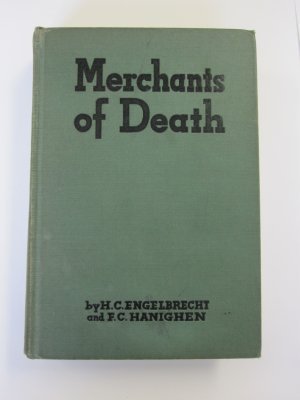
Merchants of death was an epithet used in the U.S. in the 1930s to attack industries and banks that supplied and funded World War I (then called the Great War). The term originated as the title of a book by H.C. Engelbrecht and F.C. Hanighen, Merchants of Death (1934), an expose. The term was popular in antiwar circles of both the left and the right, and was used extensively regarding the Senate hearings in 1936 by the Nye Committee.
(Source: http://en.wikipedia.org/wiki/Merchant...)
More:
http://mises.org/document/3373/
 by H.C. Engelbrecht (no photo)
by H.C. Engelbrecht (no photo)(no image) Merchants of Death Studyby H.C. Engelbrecht (no photo)
 Mrs. Henrietta Nesbitt
Mrs. Henrietta Nesbitt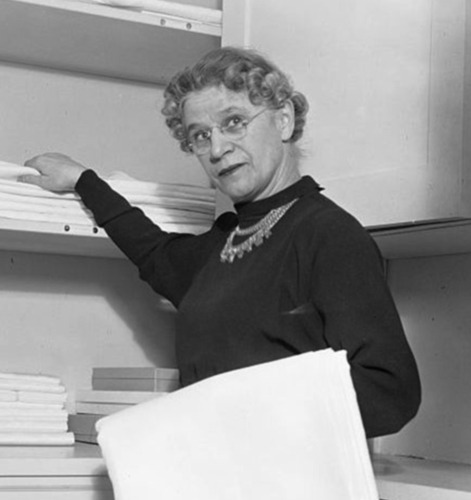
When Henrietta Nesbitt (1874-1963) first saw the White House on March 4, 1933, she remarked that it resembled “a big wedding cake.” The day was Franklin Delano Roosevelt’s first inauguration as president. The following day Nesbitt became the housekeeper at the White House. Although Mrs. Nesbitt, who was fifty-nine, had never worked as a professional housekeeper before, she was undaunted by the challenge. Her philosophy was that she had been keeping house all her life and it wouldn’t be any different at the White House, just on a larger scale. Little did Nesbitt know that she would spend more than a dozen years managing the nation’s busiest household during the trying times of the Great Depression and World War II.
Henrietta and her husband, Henry F. Nesbitt, had been neighbors of the Roosevelts in Hyde Park, New York. Eleanor Roosevelt and Nesbitt met through the formation of a local chapter of the League of Women Voters. Mrs. Roosevelt, heavily involved in her husband’s campaign for governor of New York, asked Nesbitt to make baked goods for the Roosevelt’s growing social functions at Hyde Park. When Franklin Roosevelt was elected to the White House in 1932, Mrs. Roosevelt asked both Nesbitts to work for them in the White House. Henry Nesbitt tracked the household accounts as chief steward. Two sets of books had to be kept as the government only paid for state dinners and receptions; all other meals were charged to the Roosevelts. After Henry Nesbitt’s death in 1938, Mrs. Nesbitt took over these duties with the help of an assistant.
Mrs. Nesbitt proved to be an indefatigable worker and her position involved not only care of the house, but oversight of the servants, meal planning, and the purchase of supplies from her command post on the ground floor of the historic residence. The Roosevelts were socially active and entertained over 10,000 persons during the 1937 season at the White House.
Nesbitt became a minor celebrity through her position and gave newspaper interviews about her menus. She also appeared on a radio program with other White House staffers to discuss the running of the presidential mansion. Her plain home-style meals were never widely appreciated at the White House and both President Roosevelt and visitors complained about the quality and variety of foods that were served. A 1937 New York Times article stated “any man might rebel against being served salt fish for luncheon four days in a row.” Roosevelt had a food rebellion the prior week and said that the “kitchen had better not send him any more liver for a while and he is also getting pretty tired of string beans.” Mrs. Nesbitt was aware that her menus were being discussed in the national news, but she excused it by saying that the president was stressed over world events. She also staunchly defended her uninspired menus by saying that the White House had to following rationing rules the same as everyone else. Eleanor Roosevelt ignored all criticism and remained loyal to Nesbitt. They both felt that the White House should be a model of food conservation efforts on the Home Front.
Mrs. Nesbitt remained on for a time at the White House after Harry S. Truman became president. However, Margaret Truman recounts in Bess W. Truman, that President Truman was served Brussels sprouts one too many times and Mrs. Nesbitt was summarily dismissed.
After leaving the White House, Mrs. Nesbitt wrote two books; White House Diary published in 1948 followed by The Presidential Cookbook: Feeding the Roosevelts and Their Guests in 1951. The diary is a chatty commentary of the dignitaries and heads of state that visited during her time there and provides an important glimpse of life behind the scenes at the Roosevelt White House.
(Source: http://www.whitehousehistory.org/whha...)
More:
http://www.findagrave.com/cgi-bin/fg....
http://www.gourmet.com/foodpolitics/2...
http://zenithcity.com/zenith-city-his...
http://www.ourwhitehouse.org/tasteofp...
http://www.examiner.com/article/it-s-...
http://www.mchenrycountyturningpoint....
http://mdwhome.mdw.army.mil/whta/WHTA...
http://www.newyorker.com/archive/1994...
http://www.gwu.edu/~erpapers/myday/di...
http://news.google.com/newspapers?nid...
http://www.loc.gov/pictures/item/oem2...
http://fdrsdeadlysecret.blogspot.com/...
http://lincolnslunch.blogspot.com/201...
 by
by
 Margaret Truman
Margaret Truman by Bill Harris (no photo)
by Bill Harris (no photo) by Barbara Haber (no photo)
by Barbara Haber (no photo) by Bev Young (no photo)
by Bev Young (no photo) by Henrietta Nesbitt (no photo)
by Henrietta Nesbitt (no photo)
 Paul Reynaud
Paul Reynaud
Paul Reynaud was born in Barcelonnette, France, on 15th October, 1878. He studied law at the Sorbonne and became a highly successful lawyer. A small man with tremendous energy he was nicknamed "Micky Mouse" by his friends.
Reynaud entered the Chamber of Deputies in 1914. Politically independent, he developed a reputation as a brilliant debater and held several cabinet posts in the 1930s.
An opponent of appeasement, Reynaud became a strong supporter of the military ideas of Charles De Gaulle. When Edouard Daladier was ousted in March, 1940, Reynaud became the country's new prime minister. A week later he met Neville Chamberlain in London and the men signed a joint declaration that that the two countries would not sign a separate peace with Adolf Hitler.
When the German Army invaded France in May 1940, Reynaud responded by appointed Charles De Gaulle to replace Edouard Daladier as minister of war.
Reynaud escaped to Vichy France but Henri-Philippe Petain ordered his arrest. Along with Leon Blum, Edouard Daladier and Paul Reynaud he was tried in February, 1942, for betraying his country. He was eventually handed over to the Germans who held him prisoner until 1945.
Reynaud was reelected to the Camber of Deputies in 1946. Three years later the 71-year-old Reynaud remarried and went on to father three children. Paul Reynaud died on 21st September, 1966.
(Source: http://www.spartacus.schoolnet.co.uk/...)
More:
http://en.wikipedia.org/wiki/Paul_Rey...
http://www.britannica.com/EBchecked/t...
http://www.time.com/time/covers/0,166...
http://muse.jhu.edu/login?auth=0&...
http://history.howstuffworks.com/worl...
http://www.assemblee-nationale.fr/his...
http://www.reference.com/browse/paul+...
http://worldhistoryproject.org/1940/5...
http://desertwar.net/paul-reynaud.html
http://newstalgia.crooksandliars.com/...
http://www.britishpathe.com/video/fra...
http://www.jstor.org/discover/10.2307...
 by
by
 Noel Barber (no photo)
Noel Barber (no photo) by Geoffrey Regan (no photo)
by Geoffrey Regan (no photo) by Norman Moss (no photo)
by Norman Moss (no photo) by Stephen Harding (no photo)
by Stephen Harding (no photo)(no image) In the Thick of the Fight 1930 -1945 by Paul Reynaud (no photo)
 The Atlantic Conference, 1941 (Argentia Conference)
The Atlantic Conference, 1941 (Argentia Conference)
The Atlantic Charter was a joint declaration released by U.S. President Franklin D. Roosevelt and British Prime Minister Winston Churchill on August 14, 1941 following a meeting of the two heads of state in Newfoundland. The Atlantic Charter provided a broad statement of U.S. and British war aims.
British Prime Minister Winston Churchill
The meeting had been called in response to the geopolitical situation in Europe by mid-1941. Although Great Britain had been spared from a German invasion in the fall of 1940 and, with the passage of the U.S. Lend Lease Act in March 1941, was assured U.S. material support, by the end of May, German forces had inflicted humiliating defeats upon British, Greek, and, Yugoslav forces in the Balkans and were threatening to overrun Egypt and close off the Suez Canal, thereby restricting British access to its possessions in India. When the Germans invaded the Soviet Union on June 22, 1941, few policymakers in Washington or London believed that the Soviets would be able to resist the Nazi onslaught for more than six weeks. While the British Government focused its efforts on dealing with the Germans in Europe, they were also concerned that Japan might take advantage of the situation to seize British, French, and Dutch territories in Southeast Asia.
Churchill's copy of the Atlantic Charter
Churchill and Roosevelt met on August 9 and 10, 1941 aboard the U.S.S. Augusta in Placentia Bay, Newfoundland, to discuss their respective war aims for the Second World War and to outline a postwar international system. The Charter they drafted included eight "common principles" that the United States and Great Britain would be committed to supporting in the postwar world. Both countries agreed not to seek territorial expansion; to seek the liberalization of international trade; to establish freedom of the seas, and international labor, economic, and welfare standards. Most importantly, both the United States and Great Britain were committed to supporting the restoration of self-governments for all countries that had been occupied during the war and allowing all peoples to choose their own form of government
While the meeting was successful in drafting these aims, it failed to produce the desired results for either leader. President Roosevelt had hoped that the Charter might encourage the American people to back U.S. intervention in World War II on behalf of the Allies; however, public opinion remained adamantly opposed to such a policy until the Japanese attack on Pearl Harbor in December 1941. Churchill's primary goal in attending the Atlantic Conference was "to get the Americans into the war." Barring that, he hoped that the United States would increase its amount of military aid to Great Britain and warn Japan against taking any aggressive actions in the Pacific.
Roosevelt, on the other hand, wanted the British Government to affirm publicly that it was not involved in any secret treaties, particularly ones concerning territorial questions, such as those concluded by the Allies during the First World War concerning the division of enemy territory at war's end. Roosevelt also wished to arrange the terms by which Great Britain would repay the United States for its Lend Lease assistance. Roosevelt wanted the British to pay compensation by dismantling their system of Imperial Preference, which had been established by the British Government during the Great Depression and was designed to encourage trade within the British Empire by lowering tariff rates between members, while maintaining discriminatory tariff rates against outsiders.
Churchill was extremely disappointed by Roosevelt's refusal to discuss American entry into the war. Furthermore, Churchill understood that several aspects of the proposed joint declaration might be politically damaging for the Prime Minister. Churchill worried that the abandonment of Imperial Preference would anger the protectionist wing of his Conservative Party. The Americans also proved unwilling to warn Japan too strongly against any future military action against British possessions in Southeast Asia. Finally, both Churchill and many members of his Cabinet were alarmed by the third point of the Charter, which mentions the rights of all peoples to choose their own government. Churchill was concerned that this clause acknowledged the right of colonial subjects to agitate for decolonization, including those in Great Britain's empire.
Nevertheless, Churchill realized that the joint declaration was the most he could accomplish during the conference. While the United States would remain neutral, the declaration would raise the morale of the British public and, most importantly, bind the United States closer to Great Britain. Therefore, when Churchill forwarded the text of the declaration to his Cabinet on August 11, he warned them that would it be "imprudent" to raise unnecessary difficulties. The Cabinet followed Churchill's recommendation and approved the Charter.
While the Atlantic Charter of August 1941 was not a binding treaty, it was, nonetheless, significant for several reasons. First, it publicly affirmed the sense of solidarity between the U.S. and Great Britain against Axis aggression. Second, it laid out President Roosevelt's Wilsonian-vision for the postwar world; one that would be characterized by freer exchanges of trade, self-determination, disarmament, and collective security. Finally, the Charter ultimately did serve as an inspiration for colonial subjects throughout the Third World, from Algeria to Vietnam, as they fought for independence.
(Source: http://history.state.gov/milestones/1...)
More:
http://www.historyplace.com/worldwar2...
http://avalon.law.yale.edu/subject_me...
http://news.bbc.co.uk/onthisday/hi/da...
http://en.wikipedia.org/wiki/Atlantic...
http://www.usspotomac.org/education/d...
http://militaryhistory.about.com/od/m...
http://www.kingsacademy.com/mhodges/0...
http://wwphs.sharpschool.com/UserFile...
http://www.atlanticcharter.ca/partici...
http://ww2db.com/battle_spec.php?batt...
http://www.pbs.org/behindcloseddoors/...
 by Theodore A. Wilson (no photo)
by Theodore A. Wilson (no photo) by David R. Facey-Crowther (no photo)
by David R. Facey-Crowther (no photo) Frank Costigliola (no photo)
Frank Costigliola (no photo) by Warren F. Kimball (no photo)
by Warren F. Kimball (no photo)(no image) Atlantic Meeting
 H.V. Morton
H.V. Morton
 Reconsideration vs. Recapitulation (U.S. House of Representatives)
Reconsideration vs. Recapitulation (U.S. House of Representatives)
Speaker Rayburn, a Master of House Rules, Gets Draft Extension Passed by One Vote
Reconsideration
By long tradition, the vote of the House on a proposition is not final and conclusive until there has been an opportunity to reconsider it. A proposition is not regarded as passed until a motion to reconsider it is disposed of or precluded. The motion to reconsider is thus the procedural device which permits the House, under Rule XVIII, to review its action on a given proposal. Its purpose is to allow the House to reflect on the wisdom of its action on the proposition.
(Source: https://bulk.resource.org/gpo.gov/rul...)
Reconsideration of Tie Vote
Sec. 35.2 Since a tie vote defeats a question, a Senator who voted in the affirmative is not on the prevailing side and is precluded from moving to reconsider the question.
(Source: http://www.gpo.gov/fdsys/pkg/GPO-HPRE...)
Recapitulation
The purpose of a recapitulation is the verification of the vote as cast, and a Member failing to vote on the roll call may not be recorded on recapitulation. A decision holding that recapitulation of a vote may be requested prior to final announcement of the result but not thereafter.
(Source: http://www.gpo.gov/fdsys/pkg/GPO-HPRE...)
Recapitulation: Electronic Voting (1970s-present)
A Member may not demand a recapitulation of a vote taken by electronic device. Deschler-Brown Ch 30 Sec. 31.6. The recapitulation of such votes is refused because all Members may determine whether they were correctly recorded by examining the electronic display panel over the Speaker's rostrum and because, even if the display panel is inoperative, individual votes and vote totals may be verified through the voting and monitoring stations. Deschler-Brown Ch 30 Sec. 31.7. Record votes that do not involve the use of the electronic voting system are subject to recapitulation at the discretion of the Speaker, either before or after the announcement of the result. Manual Sec. 1015; 5 Hinds Sec. Sec. 6049, 6050; 8 Cannon Sec. Sec. 3125, 3128; Deschler-Brown Ch 30 Sec. Sec. 28.2, 28.4.
(Source: http://www.gpo.gov/fdsys/pkg/GPO-HPRA...)
1940 Draft Vote
The Speaker [Rayburn]: . . . [T]he vote stands and the bill is passed and without objection a motion to reconsider is laid on the table. . . .
Mr. Short: Mr. Speaker, I was on my feet.
The Speaker: The Chair announced the vote before the recapitulation. There were no changes whatsoever and the Chair announced that the vote stood and the bill was passed, and without objection a motion to reconsider was laid on the table, and there was no objection.
Mr. Short: Mr. Speaker, I object, and I demand recognition. I wanted to move to recapitulate the vote by which the bill was passed.
The Speaker: That has already been done.
Mr. Short: I mean to reconsider the vote by which the bill was passed.
The Speaker: The vote has been recapitulated.
Mr. Short: I meant to reconsider the vote by which the bill was passed.
Mr. [Earl C.] Michener (of Michigan): Mr. Speaker, a
parliamentary inquiry.
The Speaker: The gentleman will state it.
Mr. Michener: Mr. Speaker, there is no use getting excited about this.
The Speaker: The Chair trusts the gentleman from Michigan does not think the Chair is excited.
Mr. Michener: The only thing that would make me think it was the speed with which the Speaker passed the bill and refused to recognize the gentleman from Missouri (Mr. Short), who was on the floor.
The Speaker: The gentleman did not state for what purpose.
Mr. Short: Mr. Speaker, I did not have time. I wanted to move to reconsider the vote by which the bill was passed.
The Speaker: The gentleman, in the first place, is not eligible to make that motion.
Short could not motion to reconsider the vote, because the final announcement of the vote result was already made.
(Source: http://www.gpo.gov/fdsys/pkg/GPO-HPRE...)
More:
http://www.gpo.gov/fdsys/pkg/HMAN-105...
http://www.youtube.com/watch?v=eut3JE...
http://books.google.com/books?id=OgBH...
http://books.google.com/books?id=yNRm...
 by John V. Sullivan (no photo)
by John V. Sullivan (no photo) by
by
 Jean Edward Smith
Jean Edward Smith
 Samuel Eliot Morison
Samuel Eliot Morison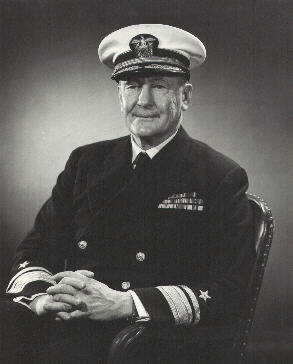
Samuel Eliot Morison, Rear Admiral, United States Naval Reserve (July 9, 1887 – May 15, 1976) was an American historian noted for his works of maritime history that were both authoritative and highly readable. He received his Ph.D. from Harvard University in 1912, and taught history at the university for 40 years. He won Pulitzer Prizes for Admiral of the Ocean Sea (1942), a biography of Christopher Columbus, and John Paul Jones: A Sailor's Biography (1959). In 1942, he was commissioned by President Franklin D. Roosevelt to write a history of United States naval operations in World War II, which was published in 15 volumes between 1947 and 1962. He retired from the navy in 1951 as a rear admiral. Morison wrote the popular Oxford History of the American People (1965), and co-authored the classic textbook The Growth of the American Republic (1930) with Henry Steele Commager. Over the course of his distinguished career, Morison received eleven honorary doctoral degrees, including degrees from Harvard University (1936), Columbia University (1942), Yale University (1949), and the University of Oxford (1951). Morison also garnered numerous literary prizes, military honors, and national awards from both foreign countries and the United States, including two Pulitzer Prizes, two Bancroft Prizes, the Balzan Prize, the Legion of Merit, and the Presidential Medal of Freedom
(Source: http://en.wikipedia.org/wiki/Samuel_E...)
More:
http://www.infoplease.com/encyclopedi...
http://www.history.navy.mil/bios/mori...
http://www.smithsonianmag.com/history...
http://backbaysun.com/2011/01/04/meet...
http://www.historians.org/info/aha_hi...
http://www.nndb.com/people/472/000045...
http://www.vdare.com/articles/samuel-...
http://www.jstor.org/discover/10.2307...
http://www.ewtn.com/library/HOMELIBR/...
http://www.history.navy.mil/prizes/pr...
http://books.google.ca/books?id=bk8EA...
 by
by
 John Keegan
John Keegan






 by
by
 Samuel Eliot Morison
Samuel Eliot Morison
 Joseph Kennedy Sr.
Joseph Kennedy Sr.

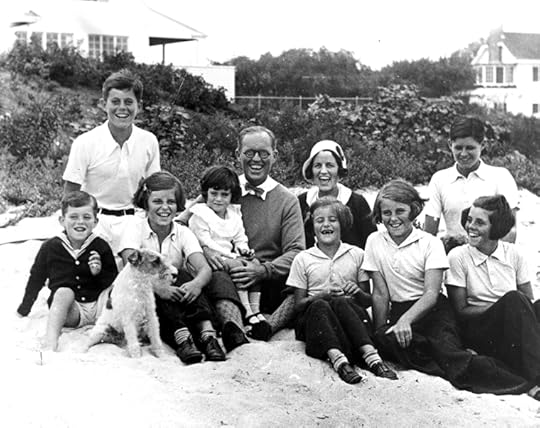
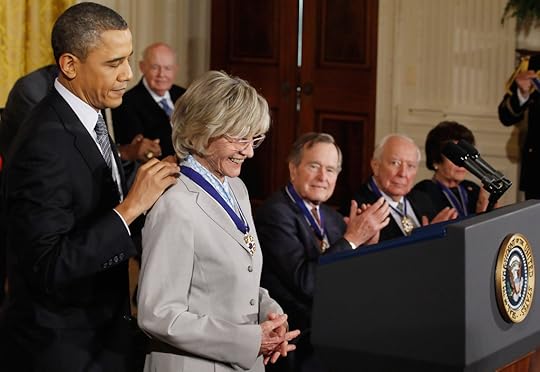
Jean Kennedy Smith, Joe's last surviving child, honored with Presidential Medal of Honor 2010
Joseph P. Kennedy, (born September 6, 1888, Boston, Massachusetts, U.S.—died November 18, 1969, Hyannis Port, Massachusetts), American businessman and financier who served in government commissions in Washington, D.C. (1934–37), and as ambassador to Great Britain (1937–40). He was the father of U.S. President John F. Kennedy and two other sons who became notable politicians.
Kennedy was the son of a Bay State politician and grandson of an Irish immigrant. In 1912 he graduated from Harvard University. Two years later he married Rose Fitzgerald, the daughter of John F. (“Honey Fitz”) Fitzgerald, mayor of Boston. Rose bore her husband nine children and taught them love, compassion, and serenity. From their father they acquired a fierce competitive drive and a yearning for distinction.
A freckled, vigorous man whose horn-rimmed spectacles gave him a slightly owlish look, Kennedy was a bank president at age 25 and a millionaire at 30. He became a shipbuilder, a motion-picture tycoon, and a heavy contributor to the Democratic Party; many have accused him of having also traded in bootleg liquor during Prohibition. In five years (1919–24) as manager of the stock division of Hayden, Stone and Company, an investment-banking firm, he mastered the art of stock-exchange manipulation. Striking out on his own, he became a brilliant plunger in the bull market of the 1920s. He retired early in 1929, having acquired enough capital to establish a million-dollar trust fund for each of his children. Then, as chairman of the Securities and Exchange Commission (1934–35) under President Franklin D. Roosevelt, Kennedy outlawed the very speculative practices that had made him rich.
Kennedy became chairman of the United States Maritime Commission and, in 1937, the first Irish-American to serve as the U.S. ambassador to Great Britain. In November 1940 he resigned; he was convinced that Britain was doomed to Nazi conquest and believed America’s only hope lay in isolationism.
By then, Kennedy’s family was complete—four sons: Joseph P., Jr., John F., Robert F., Edward M.; and five daughters: Rosemary, Kathleen, Eunice, Patricia, and Jean. Prodded by their parents, the children were competitive and cohesive. They vied with one another in sailboat races, touch football games, tennis matches, and rough-and-tumble fights.
But Kennedy was not trying to breed professional athletes. He expected his sons to prepare for public life and his daughters to be ready for marriage to distinguished men who would become “naturalized” Kennedys. The children were encouraged to read The New York Times at an early age, and small talk was not allowed at the dinner table. Instead, the family discussed national issues, sometimes with consequences not seen until years later. Joseph, Jr., for example, became an isolationist; John an ardent advocate of U.S. participation in world affairs; and Robert, perhaps because of the age gap, became shy—an affliction he battled throughout his life.
The family experienced its first misfortune when Rosemary was found to be mentally ill. Then tragedy befell Kathleen. In 1944 she married an Englishman, William Cavendish, marquess of Hartington; that same year Hartington was killed during the Allied invasion of Normandy. Four years later she herself died in a European plane crash. Joseph Kennedy had expected his eldest son to be the first Kennedy to run for public office, but young Joe was killed too, in 1944, during the war. Thus, the family’s political standard passed to the next-oldest son, John, who had planned to pursue an academic or journalistic career. John F. Kennedy served as U.S. president for 1,037 days before being assassinated in 1963; the role played by Joseph Kennedy in his son’s narrow victory over Richard Nixon for the presidency in 1960 has long been a subject of controversy. Robert F. Kennedy, who served as U.S. attorney general and as senator from New York, announced his candidacy for the presidency in mid-March 1968, but he, too, was assassinated less than three months later.
Joseph Kennedy was invalided in Hyannis Port by a stroke for several years and died at age 81.
(Source: http://www.britannica.com/EBchecked/t...)
More:
http://en.wikipedia.org/wiki/Joseph_P....
http://www.pbs.org/wgbh/americanexper...
http://www.jfklibrary.org/JFK/The-Ken...
http://www.npr.org/2012/12/12/1664880...
http://www.gwu.edu/~erpapers/mep/disp...
http://vault.fbi.gov/Joseph%20P.%20%2....
http://www.biography.com/people/josep...
http://www.forbes.com/sites/johntamny...
 by David Nasaw (no photo)
by David Nasaw (no photo) by Michael R. Beschloss (no photo)
by Michael R. Beschloss (no photo) by Laurence Leamer (no photo)
by Laurence Leamer (no photo) by Ronald Kessler (no photo)
by Ronald Kessler (no photo) by Rose Fitzgerald Kennedy (no photo)
by Rose Fitzgerald Kennedy (no photo) by Barbara A. Perry (no photo)
by Barbara A. Perry (no photo) by
by
 Edward M. Kennedy
Edward M. Kennedy
 American Youth Congress
American Youth Congress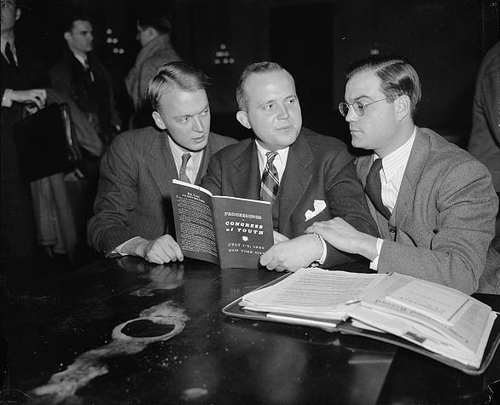
American Youth Congress was founded in 1934 as an early youth voice organization composed of youth from all across the country to discuss the problems facing youth as a whole in the 1930's. It met several years in a row - one year it notably met on the lawn of the White House. The delegates are known to have caused a disturbance when they attempted to access the United States Congress. They focused on the draft, which was taking youths at age 18 off to war. At the time in the United States one was not legally an adult in any way until one was 21. They also focused on the economic exploitation of youth.
The formation of the AYC is also widely seen as a precursor to the establishment of the National Youth Administration. Both the AYC and the NYA are notable for the support which First Lady Eleanor Roosevelt lent to them.
(Source: http://www.youthrights.net/index.php?...)
More:
http://en.wikipedia.org/wiki/American...
http://www.gwu.edu/~erpapers/teaching...
http://newdeal.feri.org/er/er26.htm
http://www.unz.org/Pub/NewMasses-1934...
http://newdeal.feri.org/students/lash...
http://www.conservapedia.com/American...
http://www.wcu.edu/about-wcu/centers-...
http://library.syr.edu/digital/guides...
 by John Thomas Flynn (no photo)
by John Thomas Flynn (no photo) by Maurine H. Beasley (no photo)
by Maurine H. Beasley (no photo) by Hazel Rowley (no photo)
by Hazel Rowley (no photo) by David M. Kennedy (no photo)
by David M. Kennedy (no photo) by Benn Steil (no photo)
by Benn Steil (no photo)
 Captain John Beardall
Captain John Beardall
Born on February 7, 1887 in Sanford, Florida.
Graduated from Annapolis in 1908 and commissioned in 1910.
Served aboard the Vermont at the occupation of Vera Cruz in April 1914. Aboard the Kansas and New Hampshire in World War I. Graduated from Naval War College in 1933. Aide to the Secretary of the Navy 1936-1939. Commanding Officer of the Vincennes 1939-1941. Aide to President Roosevelt April 1941-January 1942. Rear Admiral in November 1941. Superintendent of Annapolis January 1942-August 1945.
Retired in November 1946. Decorations included two Legions of Merit.
Died on January 4, 1967.
(Source: http://www.arlingtoncemetery.net/jrbe...)
More:
http://projects.militarytimes.com/cit...
http://www.criticalpast.com/video/656...
http://digital.lib.ecu.edu/special/pe...
http://digicoll.library.wisc.edu/cgi-...
http://www.fdrlibrary.marist.edu/dayb...
http://digital.lib.ecu.edu/special/ea...
http://www.findagrave.com/cgi-bin/fg....
http://cdm.sos.state.ga.us:2011/cdm/s...
http://select.nytimes.com/gst/abstrac...

 Christopher Andrew
Christopher Andrew by
by
 Gordon W. Prange
Gordon W. Prange by Ed Cray (no photo)
by Ed Cray (no photo) by Robert B. Stinnett (no photo)
by Robert B. Stinnett (no photo) by George H. Nash (no photo)
by George H. Nash (no photo)
 The Boer War
The Boer War
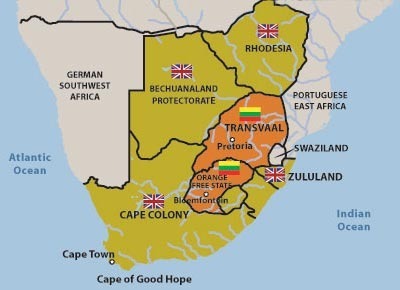
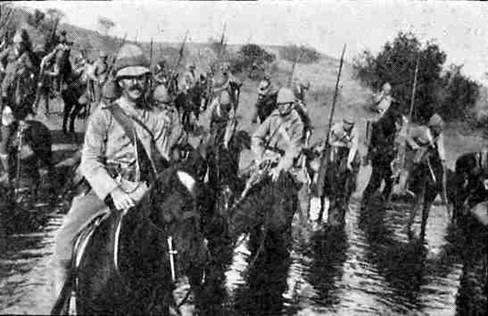
The Boer Wars was the name given to the South African Wars of 1880-1 and 1899-1902, that were fought between the British and the descendants of the Dutch settlers (Boers) in Africa. After the first Boer War William Gladstone granted the Boers self-government in the Transvaal.
The Boers, under the leadership of Paul Kruger, resented the colonial policy of Joseph Chamberlain and Alfred Milner which they feared would deprive the Transvaal of its independence. After receiving military equipment from Germany, the Boers had a series of successes on the borders of Cape Colony and Natal between October 1899 and January 1900. Although the Boers only had 88,000 soldiers, led by the outstanding soldiers such as Louis Botha, and Jan Smuts, the Boers were able to successfully besiege the British garrisons at Ladysmith, Mafeking and Kimberley.
Army reinforcements arrived in South Africa in 1900 and counter-offences relieved the garrisons and enabled the British to take control of the Boer capital, Pretoria, on 5th June. For the next two years groups of Boer commandos raided isolated British units in South Africa.
Lord Kitchener, the Chief of Staff in South Africa, reacted to these raids by destroying Boer farms and moving civilians into concentration camps. the journalist, Emily Hobhouse, visited the Bloemfontein Concentration Camp in January 1901: "When the eight, ten or twelve people who lived in the bell tent were squeezed into it to find shelter against the heat of the sun, the dust or the rain, there was no room to stir and the air in the tent was beyond description, even though the flaps were rolled up properly and fastened. Soap was an article that was not dispensed. The water supply was inadequate. No bedstead or mattress was procurable. Fuel was scarce and had to be collected from the green bushes on the slopes of the kopjes by the people themselves. The rations were extremely meagre and when, as I frequently experienced, the actual quantity dispensed fell short of the amount prescribed, it simply meant famine."
The British action in South Africa was strongly opposed by many leading Liberal politicians and most of the Independent Labour Party as an example of the worst excesses of imperialism. The Boer War ended with the signing of the Treaty of Vereeniging in May 1902. The peace settlement brought to an end the Transvaal and the Orange Free State as Boer republics. However, the British granted the Boers £3 million for restocking and repairing farm lands and promised eventual self-government (granted in 1907).
(Source: http://www.spartacus.schoolnet.co.uk/...)
More:
http://en.wikipedia.org/wiki/Boer_Wars
http://www.bbc.co.uk/history/british/...
http://www.history.com/this-day-in-hi...
http://www.awm.gov.au/atwar/boer/
http://www.anglo-boer.co.za/
http://www.bwm.org.au/site/About_the_...
http://www.victorianweb.org/history/h...
http://www.nationalarchives.gov.uk/re...
http://www.angloboerwar.com/
http://www.youtube.com/watch?v=q01rKf...
 by
by
 Arthur Conan Doyle
Arthur Conan Doyle by
by
 Thomas Pakenham
Thomas Pakenham by
by
 Winston Churchill
Winston Churchill by
by
 Sol T. Plaatje
Sol T. Plaatje by Byron Farwell (no photo)
by Byron Farwell (no photo) by Tabitha Jackson (no photo)
by Tabitha Jackson (no photo) by Roger B. Beck (no photo)
by Roger B. Beck (no photo)(no image) Young Winston's Wars: The Original Despatches of Winston S. Churchill War Correspondent, 1897-1900 by Frederick Woods (no photo)
 Randolph Churchill
Randolph Churchill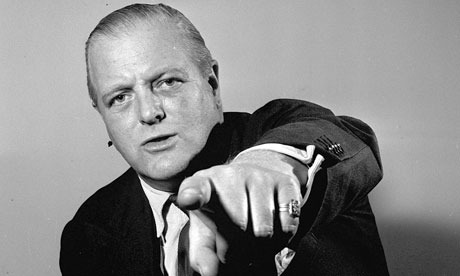
Randolph Frederick Edward Spencer-Churchill, MBE (28 May 1911 – 6 June 1968) was the son of British Prime Minister Winston Churchill and his wife Clementine. He was a Conservative Member of Parliament (MP) for Preston from 1940 to 1945. His wife from 1939 to 1946 was Pamela Harriman, who later became United States Ambassador to France and gave him a son Winston Churchill, who would follow his father into Parliament.
Early life and family
He was educated at Eton College and Christ Church, Oxford and became a journalist. In 1931 he shared Edward James's house in London with John Betjeman.
While attending Oxford, Churchill became embroiled in the controversy of February 1933 King and Country debate. Three weeks after the associated pacifist resolution was passed, Churchill proposed a resolution at the Oxford Union to delete the "King and Country" motion from the Union's records but this was defeated by 750 votes to 138 in a rowdy debate (one which was better attended than the original debate), where Churchill was met by a barrage of hisses and stink bombs. A bodyguard of Oxford Conservatives and police escorted Churchill back to his hotel after the debate. Sir Edward Heath records in his memoirs that Churchill was then chased around Oxford by undergraduates who intended to debag him (i.e. humiliate him by removing his trousers), and was then fined by the police for being illegally parked.
He was married twice. His first marriage, to the well-known socialite The Honourable Pamela Digby (later and better known as Pamela Harriman), produced a son, Winston Churchill, who became a Member of Parliament. The marriage ended in divorce in 1945. His second marriage to June Osborne produced a daughter, Arabella Churchill. It is alleged that he had an illegitimate daughter in Oklahoma in 1956. For the last twenty years of his life, he had an affair with Natalie Bevan, the wife of a friend and neighbour, Bobby Bevan. American author Christopher Ogden in his biography of Pamela Harriman has stated that while in Cairo in World War II he had a long affair with Maud (Momo) Marriott who was the wife of the senior British army officer Major General Sir John Charles Oakes Marriott.
Second World War
Randolph Churchill served with his father's old regiment, the 4th Queen's Own Hussars, and was attached for a time to the newly formed Special Air Service (SAS), joining their CO, David Stirling, on a number of missions behind enemy lines in the Libyan Desert. He also went on a military and diplomatic mission to Yugoslavia in 1944, part of the British support for the Partisans during that civil war. He and Evelyn Waugh arrived on the island of Vis on 10 July, where they met Josip Broz Tito, who had barely managed to evade the Germans after their "Operation Knight's Leap" (Rosselsprung) airdrop outside Tito's Drvar headquarters. In September that year, Churchill and Waugh established their military mission at Topusko. An outcome was a formidable report detailing Tito's persecution of the clergy. It was "buried" by Foreign Secretary Anthony Eden (who also attempted to discredit Waugh) to save diplomatic embarrassment, as Tito was then seen as a required ally of Britain and an official "friend". In both the Western Desert Campaign and Yugoslavia, Churchill crossed paths with Fitzroy Maclean, who wrote of their adventures, and some of the problems Churchill caused him, in his memoir Eastern Approaches.
Randolph Churchill's political career (like that of his son) was not as successful as that of Sir Winston or of his grandfather (Lord Randolph Churchill). In the 1935 general election he stood as an Independent Conservative, marking a temporary breach with his father's politics. He also stood in a by-election at Ross and Cromarty opposed to the National Government candidacy of Malcolm MacDonald. He was elected unopposed as Member of Parliament for Preston during the war (1940–45) to fill a vacancy, but lost his seat in the 1945 general election. He stood for parliament on many other occasions, and was defeated at each—including losing to future Labour leader Michael Foot at Plymouth Devonport in the 1951 general election.
Randolph was often portrayed as the black sheep of the Churchill family—irascible, spoiled by his father, and with a serious drinking problem. Evelyn Waugh, who was a friend, captured the mood of many after Churchill had had a growth removed by surgery. On hearing that the growth was not malignant, Waugh said "It was a typical triumph of modern science to find the one part of Randolph which was not malignant and to remove it."
Nevertheless Randolph inherited something of his father's literary flair, and carved out a career for himself as a journalist (helped by the liberal employment of ghost-writers). He started the official biography of his father in 1966, but had finished only the second volume by the time of his death in 1968. It was posthumously completed by Sir Martin Gilbert. He wrote an autobiography, Twenty-One Years, and had signed a contract with Robert Kennedy to write the biography of John F. Kennedy. As a consequence of this contract he obtained access to the Kennedy archives, but he died before beginning work.
His father declined a peerage at the end of the Second World War, and then again on his retirement in 1955 (when he was offered the Dukedom of London), ostensibly, so as not to compromise his son's political career. The main reason was actually that Churchill wanted to remain in the House of Commons[8]—by 1955, Randolph's political career was 'already hopeless'. He had been out of parliament since 1945. However, since 1911 it had become traditional for British Prime Ministers to come from the lower house of Parliament (the House of Commons). If Sir Winston Churchill had accepted a peerage, upon his death his son would have automatically been forced to move to the House of Lords, giving up his seat in the House of Commons, should he have held one. Randolph would then have been styled 2nd Duke of London. In 1963, hereditary peers were allowed to disclaim their titles, although the only peer to do so and become Prime Minister, Sir Alec Douglas-Home—previously the 14th Earl of Home—served in that office for less than a year.
Death
Randolph Churchill died of a heart attack, aged 57 (on the same day in June 1968 that Robert Kennedy was murdered). He is buried with his parents and siblings at St Martin's Church, Bladon, near Woodstock, Oxfordshire.
Fictional role
H.G. Wells in "The Shape of Things to Come", published in 1934, predicted a Second World War in which Britain would not participate but would vainly try to effect a peaceful compromise. In this vision, Randolph Churchill was mentioned as one of several prominent Britons delivering "brilliant pacific speeches" which "echo throughout Europe" but fail to end the war. Wells evidently did not expect Randolph's father Winston Churchill to have any significant role to play.
(Source: http://en.wikipedia.org/wiki/Randolph...)
More:
http://www.nndb.com/people/842/000086...
http://www.youtube.com/watch?v=zc5KXO...
http://www.nytimes.com/books/first/c/...
http://janus.lib.cam.ac.uk/db/node.xs...
http://www.britishpathe.com/video/ran...
http://www.thefifthandfinalname.com/b...
http://select.nytimes.com/gst/abstrac...
http://www.independent.co.uk/news/wor...
http://www.guardian.co.uk/theguardian...
http://ideas.time.com/letters/the-myt...
 by
by  Winston Churchill
Winston Churchill by Celia Lee (no photo)
by Celia Lee (no photo)
 by Randolph S. Churchill (no photo)
by Randolph S. Churchill (no photo)(no images) The Six Day War & The Rise And Fall Of Sir Anthony Eden & Young Statesman, 1901-1914, Companion Vol. II, 1911-1914 by Randolph S. Churchill (no photo)
(no image) Randolph Churchill by Kay Halle (no photo)
 Dardanelles
Dardanelles
The Dardanelles is a 61km (28 mile) strait between Europe and Asiatic Turkey. The maximum width is 7km and in the area known as the Narrows, the distance is no more than 1,600 metres. The Dardanelles Straits are overlooked by high cliffs on the Gallipoli Peninsula.
On the outbreak of the First World War, the Dardanelles Straits were under the control of Turkey. They were protected by outer fortresses on either shore at Kum Kale and Sedd el Bahr, linked by a run of shore batteries and minefields to the fortresses at Chanak and Kilid Bahr.
On 26th December 1914, Britain's War Council discussed the possibility of attacking Turkey in order to re-open the Dardanelles Straits. It was argued that if the operation was successful it would encourage some of the neutral Balkan states to join the Allies.
Admiral Carden proposed a three-stage operation: the bombardment of the Turkish forts protecting the Dardanelles, the clearing of the minefields and then the invasion fleet travelling up the Straits, through the Sea of Marmara to Constantinople. Carden argued that to be successful the operation would need 12 battleships, 3 battle-cruisers, 3 light cruisers, 16 destroyers, six submarines, 4 sea-planes and 12 minesweepers. Lord Kitchener, the War Minister and Winston Churchill, the First Lord of the Admiralty, liked the plan, and on their advice, Herbert Asquith, the Prime Minister, agreed for operation to go ahead.
It was hoped that the navy would force a way through the Dardanelles on its own. However, it was decided to send British troops and units of the Australian and New Zealand Corps (ANZAC) led by General William Birdwood to the Greek island of Lemnos in case they were needed to take part in the operation.
On 19th February, 1915, Admiral Carden began his attack on the Dardanelles forts. The assault started with a long range bombardment followed by heavy fire at closer range. As a result of the bombardment the outer forts were abandoned by the Turks. The minesweepers were brought forward and managed to penetrate six miles inside the straits and clear the area of mines.
Further advance up into the straits was now impossible. The Turkish forts were too far away to be silenced by the Allied ships. The minesweepers were sent forward to clear the next section but they were forced to retreat when they came under heavy fire from the Turkish batteries.
Winston Churchill became impatient about the slow progress that Carden was making and demanded to know when the third stage of the plan was to begin. Admiral Carden found the strain of making this decision extremely stressful and began to have difficulty sleeping. On 15th March, Carden's doctor reported that the commander was on the verge of a nervous breakdown. Carden was sent home and replaced by Vice-Admiral de Robeck, who immediately ordered the Allied fleet to advance up the Dardanelles Straits.
On 18th March eighteen battleships entered the straits. The fleet included Queen Elizabeth, Lord Nelson, Agamemmon, Inflexible, Ocean, Irresistible, Prince George and Majestic from Britain and the Gaulois, Bouvet and Suffren from France. At first they made good progress until the Bouvet struck a mine, heeled over, capsized and disappeared in a cloud of smoke. Soon afterwards two more ships, Irresistible and Ocean hit mines. Most of the men in these two ships were rescued but by the time the Allied fleet retreated, over 700 men had been killed. Overall, three ships had been sunk and three more had been severely damaged.
(Source: http://www.spartacus.schoolnet.co.uk/...)
More:
http://www.britannica.com/EBchecked/t...
http://www.history.com/topics/dardane...
http://en.wikipedia.org/wiki/Dardanelles
http://en.wikipedia.org/wiki/Dardanel...
http://www.nationalarchives.gov.uk/pa...
http://www.firstworldwar.com/battles/...
http://www.history.com/this-day-in-hi...
http://www.worldatlas.com/aatlas/info...
http://www.britannica.com/EBchecked/t...
http://www.iwm.org.uk/history/the-dar...
http://www.historylearningsite.co.uk/...
 by Peter Green (no photo)
by Peter Green (no photo) by Les Carlyon (no photo)
by Les Carlyon (no photo) by Roy Jenkins (no photo)
by Roy Jenkins (no photo) by Dan van der Vat (no photo)
by Dan van der Vat (no photo) by C.E. Callwell (no photo)
by C.E. Callwell (no photo)
 Union of Elder Brother of Trinity House
Union of Elder Brother of Trinity House
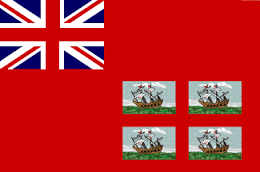
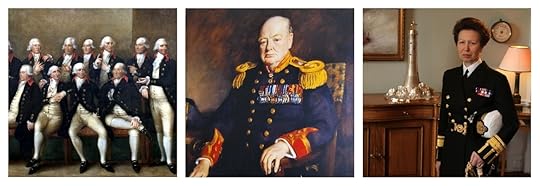
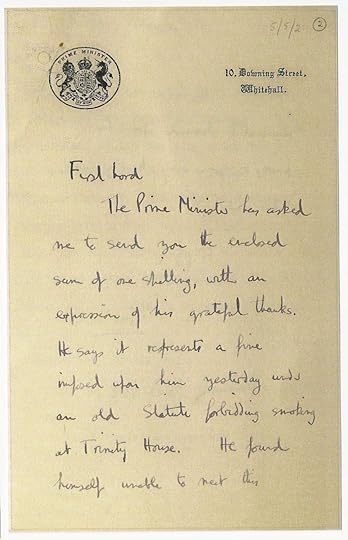
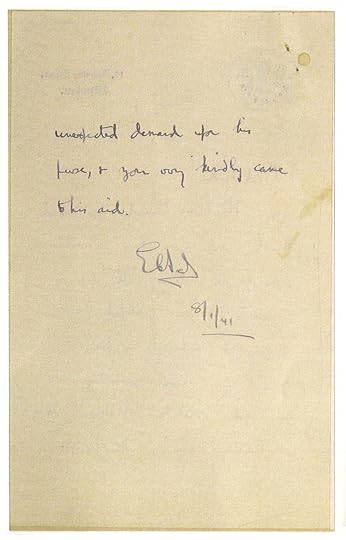
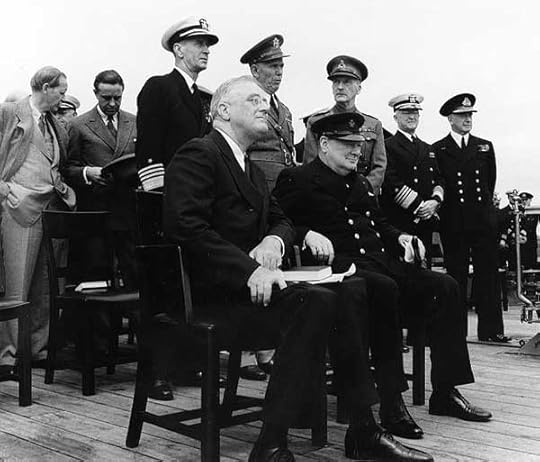
The Corporation of Trinity House of Deptford Strond, known as Trinity House, is the official General Lighthouse Authority for England, Wales, and other British territorial waters, with the exception of Scotland, the Isle of Man, and Northern Ireland. It is responsible for the provision and maintenance of navigational aids, such as lighthouses, lightvessels, buoys, and maritime radio/satellite communication systems. Trinity House is also the official deep sea pilotage authority, providing expert navigators for ships trading in Northern European waters. It is a non-departmental public body.
The Master of the Corporation (now an honorary title) is the Princess Royal. Previous Masters of Trinity House have included the diarist Samuel Pepys and the Duke of Wellington, and Admiral William Penn (father of William Penn, founder of Pennsylvania). Other prominent individuals in Britain, often connected with commercial shipping or the Admiralty, have been associated with Trinity House, including Winston Churchill, who gained his status as an Elder Brother of Trinity House as a result of his position as First Lord of the Admiralty before and during World War I. Often, especially on naval-related forays during the Second World War, he was seen in Trinity House cap or uniform. Winston Churchill also had a Trinity House vessel (THV) named after him, the THV Winston Churchill.
Trinity House is ruled by a court of thirty-one Elder Brethren, presided over by a Master, at present HRH the Princess Royal. These are appointed from 300 Younger Brethren who act as advisors and perform other duties as needed. The Younger Brethren are themselves appointed from lay people with maritime experience, mainly naval officers and ships' masters but also harbourmasters, pilots, yachtsmen and anyone with useful experience.
The headquarters of the corporation is the present Trinity House, which was designed by architect Samuel Wyatt and built in 1796. It has a suite of five state rooms with views over Trinity Square, The Tower of London and The River Thames.
The Corporation came into being in 1514 by Royal Charter granted by Henry VIII under the name "The Master, Wardens, and Assistants of the Guild, Fraternity, or Brotherhood of the most glorious and undivided Trinity, and of St. Clement in the Parish of Deptford-Strond in the County of Kent.". The first Master was Thomas Spert, captain of Henry’s flagship Mary Rose. The name of the guild derives from the church of Holy Trinity and St Clement, which adjoined the king's new dockyard at Deptford. For many years, Trinity House depots were maintained in Harwich, Great Yarmouth, Penzance, Swansea, East Cowes, and on the Thames at Trinity Buoy Wharf which closed in 1988.
In December 2002 Trinity House announced that the Great Yarmouth, Penzance and East Cowes depots would close. Today Trinity House's operational headquarters is in Harwich, supported by depots in Swansea and a flight operations base at St Just. Its operations are also supported by three vessels; the two large tenders THV Patricia and THV Galatea, and the Rapid Intervention Vessel THV Alert. A small secretariat is based at Tower Hill.
Trinity House has three main functions: It is the General Lighthouse Authority for England, Wales, the Channel Islands and Gibraltar, responsible for a range of general aids to navigation, "signs of the sea", from lighthouses to radar beacons; it is a charitable organisation dedicated to the safety, welfare and training of mariners, and; it is a Deep Sea Pilotage Authority, licensing expert navigators to act as deep sea pilots for ships trading in Northern European waters.
It no longer provides local pilots for entering ports. Contrary to popular belief Trinity House is not (and never has been) part of HM Coastguard although it does work closely with the Maritime and Coastguard Agency.
Trinity House's activities as a lighthouse authority are financed from “light dues” levied on commercial shipping calling at ports in the United Kingdom.
Assets
Trinity House maintains 69 lighthouses ranging from isolated rock towers like the Eddystone to mainland towers like Southwold lighthouse. All lighthouses have been automated since November 1998, when the UK's last manned lighthouse, North Foreland in Kent, was converted to automatic operation. Automation in the modern context began in the early 1980s, made possible firstly by the construction of lantern top helipads at remote rock lighthouses, to enable the rapid transfer of technicians to a lighthouse in the event of a breakdown, and secondly, by the development of remote control technology, which enables all lighthouses and lightvessels to be monitored and controlled from the Trinity House Operations and Planning Centre, in Harwich, Essex.
Trinity House operates three vessels around the coast of England, Wales and the Channel Islands; the THV Patricia, THV Alert, an the THV Galatea.
The historic right of Trinity House to escort the Sovereign when travelling by ship in territorial waters is still exercised on ceremonial occasions. On the River Thames and inland waterways the duty is carried out by the vessel Trinity House No 1 Boat. The name is in practice a designation of any boat assigned to this duty, rather than the name of a specific vessel, and at present a tender of THV Galatea is used for such ceremonial duties. However, for the Thames Diamond Jubilee Pageant on 3 June 2012 this boat had the name "T.H. No 1 Boat" temporarily painted onto the bow (left and right sides) whilst carrying the Master (HRH the Princess Royal) in the jubilee flotilla. (Source: http://en.wikipedia.org/wiki/Trinity_...
More:
http://www.trinityhouse.co.uk/news_in...
http://www.history.ac.uk/gh/thouse.htm
http://www.princeton.edu/~achaney/tmv...
http://trinityhousehistory.wordpress....
http://www.trinityhouse.co.uk/pdfs/tr...
http://books.google.com/books?id=7DZl...
http://www.theanswerbank.co.uk/Travel...
http://trinityhousehistory.wordpress....
 by Michael Tarrant (no photo)
by Michael Tarrant (no photo) by Jane Wilson (no photo)
by Jane Wilson (no photo)(no image)Trinity House of Deptford Transactions, 1609-35 by G.G. Harris (no photo)
(no image)Trinity House: The Super Silent Service by Michael Tarrant (no photo)
(no image)The Royal Charter of Confirmation Granted by His Most Excellent Majesty King James II, to the Trinity-House of Deptford-Strond for the Government and Encrease of the Navigation of England, and the Relief of Poor Mariners by England & Wales Sovereign (no photo)
(no image)Keepers of the Sea: A History of the Yachts and Tenders of Trinity House by
 Richard Woodman
Richard Woodman
 General Filip Golikov
General Filip Golikov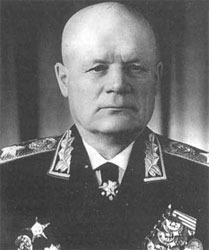
Soviet army marshal. Born in Borisovo (Kurgan Oblast), east of the Ural Mountains on 29 July 1900, Filip Golikov joined the Red Army and the Communist Party in 1918. Golikov underwent political indoctrination in Petrograd in 1919, and that August he was a political officer in the 51st Infantry Division to the end of the Russian Civil War. By 1919, he had completed advanced leadership training. He was involved primarily in political work until 1931, when he undertook command of an infantry regiment. Golikov graduated by correspondence from the Frunze Military Academy with a specialty in armor in 1933. He had charge of the 8th Mechanized Brigade during 1936 and 1937 and of the Mechanized Corps of the Kiev Military District during 1937 and 1938.
Golikov held commands in the Soviet invasion of Poland in September 1939 and perhaps of Finland. He was promoted to major general in May 1940 and assigned as deputy chief of the General Staff and chief of military intelligence. Reporting only to Josef Stalin, he passed along information from Russian spy Richard Sorge that Japan would strike south in 1941 rather than drive north into the Soviet Union. Shortly after Germany invaded the Soviet Union in June 1941, Golikov led missions to London and Washington to negotiate aid.
Golikov took command of the Tenth Army in October 1941 in the defense of the city of Moscow, participating in the desperate fighting there in December. He headed the Fourth Assault Army in the winter counteroffensive of February and March 1942 and then headed the Bryansk Front opposing German Army Group South's summer offensive in June 1942. During the August 1942–January 1943 Battle of Stalingrad, Golikov commanded first the Voronezh Front and then the First Guards Army. He was also deputy commander of the Southeast and Stalingrad Fronts. He headed the Voronezh Front from October 1942 to March 1943 and took part in the Soviet push through Kursk and Kharkov.
Promoted to colonel general in January 1943, Golikov was deputy commissar of defense for cadres and chief of the personnel directorate of the Red Army from 1943 to 1950. In 1945, he was promoted to general of the army. Golikov was then commander of the Special Mechanized Army from 1950 to 1956 and commandant of the Military Academy of Armored Troops in 1956. From 1957 to 1962, he was chief of the Main Political Administration of the Soviet Armed Forces. In 1961, he was promoted to marshal. Following his disagreement with Nikita Khrushchev over the latter's handling of the Cuban missile crisis, Golikov was quietly relieved of his posts and shunned by his fellow officers. He served out his remaining active service in a succession of administrative positions until 1966. Golikov died in Moscow on 8 August 1980.
(Source: http://www.historyandtheheadlines.abc...)
More:
http://en.wikipedia.org/wiki/Filipp_G...
http://www.generals.dk/general/Goliko...
http://news.google.com/newspapers?nid...
http://news.google.com/newspapers?nid...
http://en.valka.cz/viewtopic.php/t/230
http://www.thinktankconsulting.ca/fil...
http://persona.rin.ru/eng/view/f/0/36...
http://mitchtemppiece.blogspot.com/20...
http://www.jstor.org/discover/10.2307...
http://www.answers.com/topic/general-...
 by
by
 David M. Glantz
David M. Glantz by Albert Seaton (no photo)
by Albert Seaton (no photo) by Harold Shukman (no photo)
by Harold Shukman (no photo) by John Hughes-Wilson (no photo)
by John Hughes-Wilson (no photo) by Roger R. Reese (no photo)
by Roger R. Reese (no photo) by Marta Dyczok (no photo)
by Marta Dyczok (no photo)
 Battle of Gallipoli
Battle of Gallipoli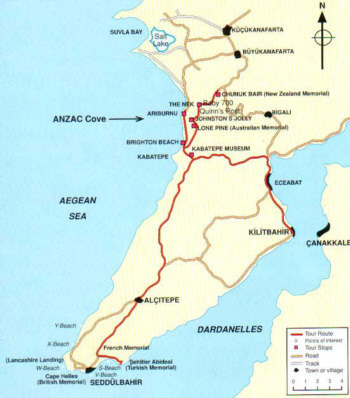
[image error]
By 1915 the Western Front was clearly deadlocked. Allied strategy was under scrutiny, with strong arguments mounted for an offensive through the Balkans or even a landing on Germany's Baltic coast, instead of more costly attacks in France and Belgium.
These ideas were initially sidelined, but in early 1915 the Russians found themselves threatened by the Turks in the Caucasus and appealed for some relief. The British decided to mount a naval expedition to bombard and take the Gallipoli Peninsula on the western shore of the Dardanelles, with Constantinople as its objective. By capturing Constantinople, the British hoped to link up with the Russians, knock Turkey out of the war and possibly persuade the Balkan states to join the Allies.
The naval attack began on 19 February. Bad weather caused delays and the attack was abandoned after three battleships had been sunk and three others damaged. Military assistance was required, but by the time troops began to land on 25 April, the Turks had had ample time to prepare adequate fortifications and the defending armies were now six times larger than when the campaign began.
Against determined opposition, Australian and New Zealand troops won a bridgehead at 'Anzac Cove' on the Aegean side of the peninsula. The British, meanwhile, tried to land at five points around Cape Helles, but established footholds in only three before asking for reinforcements. Thereafter little progress was made, and the Turks took advantage of the British halt to bring as many troops as possible onto the peninsula.
This standstill led to a political crisis in London between Churchill, the First Lord of the Admiralty and the operation's chief advocate, and Lord Fisher, the First Sea Lord, who had always expressed doubts about it. Fisher demanded that the operation be discontinued and resigned when overruled. The Liberal government was replaced by a coalition and Churchill, though relieved of his former post, remained in the War Council.
Amid sweltering and disease-ridden conditions, the deadlock dragged on into the summer. In July the British reinforced the bridgehead at Anzac Cove and in early August landed more troops at Suvla Bay further to the north, to seize the Sari Bair heights and cut Turkish communications. The offensive and the landings both proved ineffectual within days, faced with waves of costly counter-attacks.
The War Council remained divided until late 1915 when it was decided to end the campaign. Troops were evacuated in December 1915 and January 1916. Had Gallipoli succeeded, it could have ended Turkey's participation in the war. As it was, the Turks lost some 300,000 men and the Allies around 214,000, achieving only the diversion of Turkish forces from the Russians. Bad leadership, planning and luck, combined with a shortage of shells and inadequate equipment, condemned the Allies to seek a conclusion in the bloody battles of the Western Front. Furthermore, Gallipoli's very public failure contributed to Asquith's replacement as Prime Minister by David Lloyd George in December 1916.
(Source: http://www.bbc.co.uk/history/worldwar...)
More:
http://www.history.com/topics/battle-...
http://militaryhistory.about.com/od/w...
http://www.firstworldwar.com/battles/...
http://www.historylearningsite.co.uk/...
http://en.wikipedia.org/wiki/Gallipol...
http://www.pbs.org/greatwar/maps/maps...
http://www.nzhistory.net.nz/war/the-g...
http://www.ataturktoday.com/1915Galli...
http://www.youtube.com/watch?v=feVOwt...
http://www.youtube.com/watch?v=vXAtMJ...
http://www.anzacsite.gov.au/
http://worldhistoryproject.org/1915/4...
http://www.theartofbattle.com/battle-...
 by
by
 Alan Moorehead
Alan Moorehead by
by
 Peter Hart
Peter Hart by Les Carlyon (no photo)
by Les Carlyon (no photo) by Robert Rhodes James (no photo)
by Robert Rhodes James (no photo) by Harvey Broadbent (no photo)
by Harvey Broadbent (no photo) by John M. Coates (no photo)
by John M. Coates (no photo) by Edward J. Erickson (no photo)
by Edward J. Erickson (no photo)(no image) The Story of Anzac: From 4 May 1915 to the Evacuation of the Gallipoli Peninsula by C.E.W. Bean (no photo)
 Mayor Fiorello LaGuardia
Mayor Fiorello LaGuardia

The son of immigrants of Italian and Jewish ancestry, Fiorello LaGuardia, or "Little Flower," is widely regarded as one of the best mayors in New York City history, whose tenure redefined the office. LaGuardia had a long distinguished career in public service, beginning when he was 17 in the U.S. Consulate Service in Europe, where he became fluent in Yiddish, German, French and Italian. Upon graduating New York University Law School in 1910, LaGuardia practiced law and was appointed Deputy Attorney General. LaGuardia was elected to Congress in 1916 on a Republican ticket, interrupting his term to serve as a decorated pilot on the Italian front in World War I (his plane was named the Congressional Limited). He was elected President of the Board of Alderman in 1919 and returned to Congress in 1923, winning reelection repeatedly. After losing the mayoral election to Jimmy Walker in 1929, he successfully ran for mayor again in 1933 on a fusion ticket against Tammany Hall.
LaGuardia shunned the traditional inauguration day ceremony, instead making numerous appearances, at each one vowing to "clean house and clean it thoroughly." On his first day in office, he delivered a radio address to the nation, declaring: "New York City was restored to the people this morning at one minute after midnight. It is my duty from now on to guard and protect and guide the complete, peaceful and undisturbed enjoyment of that possession."
For the next twelve years, the 5 foot 2, sometimes belligerent chief executive dominated life in New York City. He fulfilled many of his pledges, ferreting out corruption in city government and bringing in talented professionals. LaGuardia earned a reputation for placing the city's interests ahead of political considerations. Although technically a Republican, he worked closely with the New Deal administration of President Franklin Roosevelt to secure funding for large public works projects. The federal subsidies enabled New York City to create a transportation network the envy of the world, and to build parks, low-income housing, bridges, schools, and hospitals. He achieved the unification of the city's rapid transit system, a goal that had long eluded his predecessors, and reformed the structure of city government by pushing for a new City Charter. He presided over construction of New York City's first municipal airport on Flushing Bay, later appropriately named LaGuardia Airport.
LaGuardia's psychological effect on New York City was equally profound, restoring faith in city government by demanding excellence from civil servants. He was perceived as ubiquitous, always first to appear at a fire or natural disaster; he sometimes dropped in at city agencies unannounced, periodically conducted the municipal orchestra, spoke weekly over the radio, and once used that medium to read the comics to New Yorkers during a citywide newspaper strike.
In 1945, the first three-term New York City mayor decided not to seek a fourth term, perhaps hoping to enter national politics. After leaving office, he hosted a weekly radio show and was appointed Director General of the United Nations Relief and Rehabilitation Commission. LaGuardia succumbed to pancreatic cancer on September 21, 1947 at his home in Riverdale, Bronx.
(Source: http://www.nyc.gov/html/nyc100/html/c...)
More:
http://www.britannica.com/EBchecked/t...
http://en.wikipedia.org/wiki/Fiorello...
http://bible.org/illustration/mayor-l...
http://www.nytimes.com/learning/gener...
http://www.csmonitor.com/Books/Book-R...
http://www.infoplease.com/biography/v...
http://www.sicilianculture.com/people...
http://www.spartacus.schoolnet.co.uk/...
http://www.freebase.com/en/fiorello_h...
http://www.jewishvirtuallibrary.org/j...
 by Alyn Brodsky (no photo)
by Alyn Brodsky (no photo) by H. Paul Jeffers (no photo)
by H. Paul Jeffers (no photo) by Mason B. Williams (no photo)
by Mason B. Williams (no photo) by Thomas Kessner (no photo)
by Thomas Kessner (no photo) by Ronald H. Bayor (no photo)
by Ronald H. Bayor (no photo)(no image) Little Flower: The Life And Times Of Fiorello La Guardia by Lawrence Elliott (no photo)
 A. Wayne Coy
A. Wayne Coy
From Franklin High School to Franklin College to the Franklin Star to Franklin Delano Roosevelt. Such was Albert Wayne Coy’s progression from student to newspaper city editor to close adviser to the president of the United States.
And, of course, there’s more to the story of Coy’s life. He also was an Indiana governor’s right-hand man; he helped his state and nation administer Depression-era and wartime programs designed to aid the poor and jobless; he served his nation abroad in the Philippines; he headed the Federal Communications Commission; and he returned to Indiana to begin a new facet of his career with media giant Time Inc. But he didn’t get to finish that last facet because he was claimed at age 53 by a hear attack on September 24, 1957, just a few months after he had come back home again to Indiana.
Coy was born in Shelbyville and moved just a dozen or so miles down the road to Franklin, where he attended high school and college. He graduated from Franklin College in 1926 and later received an honorary doctorate from his alma mater. By age 16, he was a reporter on the Franklin Star, where he later became city editor. In 1930, he bought the weekly Delphi Citizen and was its publisher until 1933.
That’s when the political bug but this son of a Republican family. But it was a Democratic bug. The Delphi Citizen had Democratic political leanings, and Coy made the move from newspapering to politics. First he was a party chauffeur, driving candidates from campaign stop to campaign stop. Soon, though, he caught the eye of Gov. Paul V. McNutt, who named Coy his undersecretary in early 1933. By August 1934, Coy had become director of Indiana’s welfare department and also state and regional director of McNutt’s Commission on Unemployment Relief. He later was state and regional director of the Works Progress Administration and was in charge of Indiana’s prison system.
In 1936, he was named head of a new state agency, the Department of Public Welfare. In that job, his initiatives brought praise from Harry L. Hopkins, FDR’s lease-lend administrator. Soon, Hopkins asked Coy to administer WPA programs in several Midwest states, a foreshadowing of Coy’s impending move to Washington, D.C. But first came a move to Philippines with McNutt, who became U.S. High Commissioner to that nation. McNutt and Hopkins were Coy’s links to FDR. After Philippines, Coy was administrative assistant to McNutt when the former governor was named to head the Social Security Agency. In fact, one reporter speculated that Hopkin’s knowledge of Coy had much to do with McNutt’s appointment. That reporter, Everett C. Watkins of The Indianapolis Star, wrote from Washington in April 1941 about the FDR-Coy relationship this way:
"Wayne Coy was completely unknown to the President at the time of Mr. Roosevelt’s election in 1932. But for the last four or five years the President has shown an increasing interest in Mr. Coy who was introduced to him by Hopkins…
"It has been recognized here (Washington) for a long time that Coy has a standing with President Roosevelt that is closer than that of any other Indiana Democrat."
Coy became seriously ill after arriving in Washington — "following an operation he was in a Baltimore hospital for mare than six months and for a time doctors despaired of saving his life," Watkins wrote — but recovered, and at age 37 was named as the liaison between FDR and the Office of Emergency Management in 1941 at the outset of World War II. At that point, his old boss, Gov. McNutt, commented: "Wayne Coy is so big in ability that he will measure up to any job, no matter how important." And Watkins observed: "Mr. Coy, in his increasingly important work, will become a personal agent for the President; all his acts and deeds will be recognized as representative of the President’s wishes. Coy and Hopkins will be personal representatives of the President even more than any Cabinet member."
In 1942, he became assistant budget director, a spot he held for two years. Five years later, Coy went from the service of Harry Hopkins to the service of Harry Truman, who had become president after FDR’s death. In 1947, Truman needed a new chairman for the FCC, an administrator to oversee broadcast media, which included this still infant thing called television. Coy became Truman’s chairman, and it was during Coy’s five-year tenure that color television came fully into being. Fittingly, as Coy’s friend, the late Eldon Campbell, noted a few years ago, Coy’s portrait as chairman was the first in color to be hung in the FCC meeting room.
In 1952, Coy resigned from the FCC and joined Time Inc. One of his first tasks was purchasing the KOB radio and TV stations in Albuquerque. He held half-interest in those stations and was their president in manager. In spring of 1957, when Time Inc. bought the WFBM stations in Indianapolis, it asked Coy to return to his native state to run them.
But in less that six months, death would prevent Coy from finishing his career, back home in Indiana, just a few miles from Franklin where it all began. Still, as his good friend Campbell wrote, "Wayne Coy was…one of those men who crammed an amazing career into a few short years."
Coy is survived by sons Stephen Coy, now retired, and Wayne Coy, a communications lawyer in Washington, D.C.
(Source: http://indianajournalismhof.org/1995/...)
More:
http://www.kob.com/article/533/
http://en.wikipedia.org/wiki/Wayne_Coy
http://en.wikipedia.org/wiki/Federal_...
http://docs.fdrlibrary.marist.edu:800...
http://content.lib.utah.edu/cdm/ref/c...
http://transition.fcc.gov/commissione...
http://www.nndb.com/gov/692/000042566/
http://www.questia.com/library/1G1-16...
http://libserv23.princeton.edu/prince...-----
http://www.jstor.org/discover/10.2307...
 by
by
 Studs Terkel
Studs Terkel by David L. Smith (no photo)
by David L. Smith (no photo) by Nelson Lichtenstein (no photo)
by Nelson Lichtenstein (no photo) by Federal Writers' Project (no photo)
by Federal Writers' Project (no photo)(no image) Radio and Television Regulation: Broadcast Technology in the United States, 1920-1960 by Hugh R. Slotten (no photo)
Books mentioned in this topic
Eisenhower in War and Peace (other topics)The Battle of Sicily: How the Allies Lost Their Chance for Total Victory (other topics)
The Battle of Sicily: How the Allies Lost Their Chance for Total Victory (other topics)
The Devils' Alliance: Hitler's Pact with Stalin, 1939-1941 (other topics)
The Jew Who Defeated Hitler: Henry Morgenthau Jr., FDR, and How We Won the War (other topics)
More...
Authors mentioned in this topic
Jean Edward Smith (other topics)Samuel W. Mitcham Jr. (other topics)
Samuel W. Mitcham Jr. (other topics)
Roger Moorhouse (other topics)
Peter Moreira (other topics)
More...






Sumner Welles was born into a wealthy New York family in 1892, the namesake of his great-uncle, Charles Sumner, the crusading abolitionist senator from Massachusetts. As a young man from a rich and socially important family, Welles followed FDR's educational path by attending Groton and Harvard before entering the foreign service in 1915.
Welles quickly distinguished himself as an eloquent foreign service officer and navigated the State Department's political waters so skillfully that he was promoted to acting chief of its Latin American Affairs Division after only a few years of field work. Welles' meteoric rise, however, also insured that he would quickly run out of promotions to seek, and as a result he did not remain at the State Department for very long. In March 1922, Welles resigned his position with the State Department to pursue a lucrative career in banking.
As a private citizen, Welles continued to study Latin America and to comment on international affairs, all the while maintaining a friendship with Franklin and Eleanor Roosevelt, whom he had known since boyhood. After the election of 1932, FDR invited Welles to advise him on Latin American affairs, and in 1933 he became assistant secretary of state. Welles quickly achieved notoriety within the administration as the architect of the "Good Neighbor" policy, and when Cubans revolted against their government FDR quickly nominated Wells to the ambassadorship and dispatched him to Havana.
Despite his assignment to the American embassy in Cuba, however, Welles continued to be a member of the White House foreign policy inner circle and FDR's most trusted adviser on Latin America. As a result he was promoted to undersecretary of state in 1937, and helped to draft the Atlantic Charter, an Anglo-American declaration of principles, in 1941.
Even though he had a strong record at the State Department, Welles was unable to improve his relationship with Secretary of State Cordell Hull, who felt that Welles' closeness to the president undermined his own ability to act as FDR's chief foreign policy adviser. Never completely comfortable with Welles as his deputy, Hull threatened resignation in August 1943 if Welles was not removed from the administration over allegations that he had engaged in homosexual conduct. FDR reluctantly agreed, and Welles tendered his resignation shortly thereafter.
In retirement, Welles continued to write and publish commentary, most of which related to international affairs and to his vision for a multilateral global community. He died in 1961 at the age of 68.
(Source: http://www.gwu.edu/~erpapers/teaching...)
More:
http://www.nytimes.com/books/first/w/...
http://en.wikipedia.org/wiki/Sumner_W...
http://www.history.com/this-day-in-hi...
http://www.reformation.org/welles-con...
http://www.ralphmag.org/wellesH.html
http://www.nndb.com/people/793/000119...
http://www.fdrlibrary.marist.edu/arch...
http://hdtd.typepad.com/hdtd/2007/12/...
http://www.foreignaffairs.com/article...
http://spinzialongislandestates.com/S...
http://biography.yourdictionary.com/s...
(no image) American National Biography, Volume 23: Wellek - Wrenn by John A. Garraty (no photo)